You are using an outdated browser. Upgrade your browser today or install Google Chrome Frame to better experience this site.
Use this checklist to prepare for your next trip abroad. Make sure to bring items with you, since quality of items bought overseas cannot be guaranteed. Not all of these items may be relevant to you and your travel plans.

Pack for a Healthy Trip
Prescription medicines
- Your prescriptions
- Travelers’ diarrhea antibiotic
- Medicines to prevent malaria
Medical supplies
- Glasses and contacts
- Medical alert bracelet or necklace
- Diabetes testing supplies
Over-the-counter medicines
- Diarrhea medicine (Imodium or Pepto-Bismol)
- Antihistamine
- Motion sickness medicine
- Cough drops, cough suppressant, or expectorant
- Decongestant
- Pain and fever medicine (acetaminophen, aspirin, or ibuprofen)
- Mild laxative
- Mild sedative or sleep aid
Supplies to prevent illness or injury
- Hand sanitizer (containing at least 60% alcohol) or antibacterial hand wipes
- Water purification tablets
- Insect repellent (with an active ingredient like DEET or picaridin)
- Sunscreen (with UVA and UVB protection, SPF 15 or higher)
- Sunglasses and hat
First-aid kit
- 1% hydrocortisone cream
- Antibacterial or antifungal ointments
- Digital thermometer
- Oral rehydration salts
- Antiseptic wound cleaner
- Aloe gel for sunburns
- Insect bite anti-itch gel or cream
- Disposable gloves
- Cotton swabs (Q-Tips)
- Copies of your passport and travel documents
- Copies of all prescriptions (medications, glasses, or medical supplies)
- Health insurance card and documents
- Proof of yellow fever vaccination (if required for your trip)
- Contact card with the street addresses, phone numbers, and e-mail addresses of: Family member or close contact in the United States
- Health care provider(s) at home
- Lodging at your destination
- Hospitals or clinics (including emergency services) in your destination
- US embassy or consulate in the destination country or countries
Additional Resources
- Check the Transportation Security Administration website for updates on permitted and prohibited items, including medicines that you are allowed to carry onto an airplane.
- Some items may not be allowed in other countries. It is a good idea to check the Customs and Import Restrictions section of the U.S. Department of State Tips for Traveling Abroad.
- Enroll in the Department of State Smart Traveler Enrollment Program to get the latest safety updates and help in an emergency.
File Formats Help:
- Adobe PDF file
- Microsoft PowerPoint file
- Microsoft Word file
- Microsoft Excel file
- Audio/Video file
- Apple Quicktime file
- RealPlayer file
- Zip Archive file
Exit Notification / Disclaimer Policy
- The Centers for Disease Control and Prevention (CDC) cannot attest to the accuracy of a non-federal website.
- Linking to a non-federal website does not constitute an endorsement by CDC or any of its employees of the sponsors or the information and products presented on the website.
- You will be subject to the destination website's privacy policy when you follow the link.
- CDC is not responsible for Section 508 compliance (accessibility) on other federal or private website.
Nomadic Matt's Travel Site
Travel Better, Cheaper, Longer
How To Pack A Professional Travel First Aid Kit
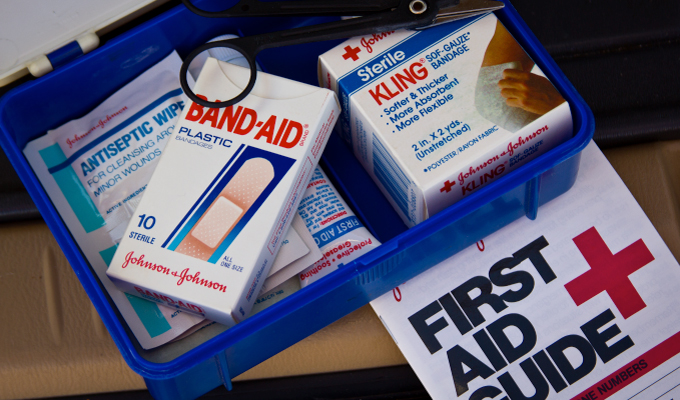
I get a lot of questions about health care on the road. Since I’m not a doctor, I don’t like giving medical advice beyond a few general tips so I’ve asked Mike Huxley, a registered nurse, to share his expert tips and advice when it comes to packing a first aid kit for your travels.
I have been traveling the world for over fifteen years now, and in that time I have patched up more travelers’ scrapes and sprains than I can remember.
Thankfully, pretty much all of the incidents I have dealt with so far have been minor. Even during my time spent volunteering as an expedition medic in the Sahara, the jungles of Kalimantan and Borneo, and many other amazing places, I have been able to deal with most accidents and injuries that have crossed my path.
I have only been able to do all of this, however, because I have always packed my trusty first aid kit. It has evolved and been refined over the years, but I have always carried one.
As any experienced traveler or health professional will tell you, things can and occasionally do go wrong on any trip , and taking a well-stocked kit with you is always advised.
When I first started traveling, I did what most sensible people do and carried a commercially available emergency first aid kit .
However, over the years, and with a lot of experience and my nursing qualification behind me, I have refined my own kit to reflect what I will use out on the road and what I know will make for a much better first aid kit for the average traveler too.
The best first aid kits are simple but varied and have a variety of dressings and equipment to deal with the basics. More importantly, they can be used with little or no training. So, what items should you include? Here are my picks for the essentials:
1. Band-Aids/Plasters It goes without saying that these are absolutely essential in any first aid kit. The most common form of minor injury is a cut or a graze, so it is always a good idea to carry a handful of Band-Aids in a variety of sizes .
If you think you will be doing a lot of trekking on your travels and you aren’t used to that form of exercise, then some blister plasters are a good idea.
It isn’t necessary to go overboard and carry so many you could start your own tiny field hospital; just a few of each type will do, as you can always restock when you pass a pharmacy.
2. Gauze Gauze is the medical jack-of-all-trades. I never carry a first aid kit without a supply of gauze in it, and I can’t tell you how many times it has come in useful over the years. It can be used to apply pressure to a wound, clean an injury, soak up blood, help stop bleeding, and even form part of a basic dressing for small-to-medium wounds.
A clean wound and a layer of gauze kept down with either tape or an adhesive bandage is often enough to allow time for you to go and get it looked at by a professional.
The best type of gauze to carry in a first aid kit is individually wrapped sterile squares. This eliminates the need to cut them to size when you need them quickly and obviously makes it easier to keep the wound clean and sterile.
3. Crepe bandages (ACE or elastic bandages) For when you have something a bit bigger than a cut, basic crepe bandages are useful for keeping small dressings clean and in place until you can get some medical attention.
Remember, you’re only going to use them in an emergency, until you can get some professional medical care (ideally covered through the travel insurance that you got in advance of your trip). You don’t need too many of these, just one or two at most.
4. Surgical tape Surgical tape is one of those essential emergency items for when you need to apply and secure gauze or a bandage to a wound, although Band-Aids can do the same job if need be.
5. Small scissors These come standard in any commercially available first aid kit (although you can buy them separately too) and are obviously useful for trimming gauze or bandages to size. Just be careful if you do carry scissors to ensure that your first aid kit goes in your checked bag when you are in transit or else airline security will take them off you.
If you’re flying carry-on only, small scissors (max 4 inches/10 centimeters) are permitted according to the TSA. If you want to be on the safe side, get ones with rounded tips. Also, remember that you don’t need to bring them from home — most grocery stores or stationery shops have them as well.
6. Tweezers Tweezers are another item that often comes standard in most first aid kits and can be useful for pulling out splinters, getting out little bits of stone or dirt when cleaning a wound, or any number of other practical uses.
7. Antiseptic wipes For some reason this tends to be the one thing most people overlook when thinking of first aid, but antiseptic wipes are an absolute essential in any good pack. No one wants a cut or wound to get infected, and antiseptic wipes are perfect for cleaning it before applying a dressing.
Just a small handful will suffice for most packs. Like most basic items, they are easy to replace at any pharmacy when you run low.
8. Condoms Apart from the obvious benefits (staying sexually safe), these handy little items can be used as emergency water carriers or even filled with ice as an emergency ice pack. I’ve personally never had any call to use them in that manner, but it is a handy bit of information to keep in mind.
9. Pain relief medication A small pack of basic acetaminophen (also known as paracetamol) or any of the associated brand names ( like Tylenol ) is usually sufficient, but ibuprofen or other similar medications are fine too. It doesn’t have to be fancy — basically whatever you normally take for pain relief when you have a headache or minor pain.
10. Loperamide tablets Also known under a variety of brand names such as Imodium , this is useful for stopping diarrhea for short periods when you need to catch a bus or train. Remember, these are for those emergency moments only when you are actually in transit, as they do not cure diarrhea and shouldn’t be used when you can rest up for a couple of days. (Normally the best way to treat diarrhea is to let everything pass through your system normally and drink plenty of water to replace lost fluids.)
If you use them sparingly, properly, and as directed on the pack, loperamide tablets can be useful additions to any travel first aid kit.
11. Antihistamine cream It happens to all of us on our travels: we get bitten by some form of insect and end up with a painfully itchy bump or rash. Don’t worry, the absolute majority of the time the bumps and stings aren’t anything to worry about at all, but they are damned annoying! This is why a good antihistamine cream is a useful addition to help control itching and swelling.
12. Antibacterial creams It’s also a good idea to carry antibacterial creams like Neosporin for any cuts and scrapes you get. This will help heal them faster as well as prevent any possible infections.
Obviously, this list can be tailored or added to depending on your trip needs (a tropical jungle trek will require different planning than a city break in Europe ). Any good first aid kit should also include any specific, individually prescribed medication or antimalarial prophylaxis.
For the majority of travelers, however, the items and kit listed above will cover the majority of basic incidents and accidents. You’ll also want to make sure you have comprehensive travel insurance as well to protect you against unexpected costs that you might incur should an emergency happen.
For any injury, illness, bang, or scrape that requires more than the basics and cannot be covered by the kit above, you should seek professional medical attention. Unless you are extremely far off the beaten track, you should be able to seek out professional assistance to deal with medical emergencies pretty easily if something happens you can’t handle yourself.
So go pack up your own little first aid kit and keep it stashed in your pack for emergencies. Odds are you will probably never use it — and I hope you never need to — but if you have one, at least you can enjoy your travels with peace of mind and be safe in the knowledge that you are prepared.
Important Note: When carrying any generic medication, it is essential that it is kept in its original packaging when you are traveling in case customs officials need to check it. The information provided here is for general travel health advice and information only. It is provided by a qualified nurse, but it is not a replacement for a personal consultation with a travel nurse specialist, your GP, or a doctor specializing in travel medicine who can tailor advice to your individual medical history and needs.
Book Your Trip: Logistical Tips and Tricks
Book Your Flight Find a cheap flight by using Skyscanner . It’s my favorite search engine because it searches websites and airlines around the globe so you always know no stone is being left unturned.
Book Your Accommodation You can book your hostel with Hostelworld . If you want to stay somewhere other than a hostel, use Booking.com as it consistently returns the cheapest rates for guesthouses and hotels.
Don’t Forget Travel Insurance Travel insurance will protect you against illness, injury, theft, and cancellations. It’s comprehensive protection in case anything goes wrong. I never go on a trip without it as I’ve had to use it many times in the past. My favorite companies that offer the best service and value are:
- SafetyWing (best for everyone)
- Insure My Trip (for those 70 and over)
- Medjet (for additional evacuation coverage)
Want to Travel for Free? Travel credit cards allow you to earn points that can be redeemed for free flights and accommodation — all without any extra spending. Check out my guide to picking the right card and my current favorites to get started and see the latest best deals.
Need Help Finding Activities for Your Trip? Get Your Guide is a huge online marketplace where you can find cool walking tours, fun excursions, skip-the-line tickets, private guides, and more.
Ready to Book Your Trip? Check out my resource page for the best companies to use when you travel. I list all the ones I use when I travel. They are the best in class and you can’t go wrong using them on your trip.
Got a comment on this article? Join the conversation on Facebook , Instagram , or Twitter and share your thoughts!
Disclosure: Please note that some of the links above may be affiliate links, and at no additional cost to you, I earn a commission if you make a purchase. I recommend only products and companies I use and the income goes to keeping the site community supported and ad free.
Related Posts
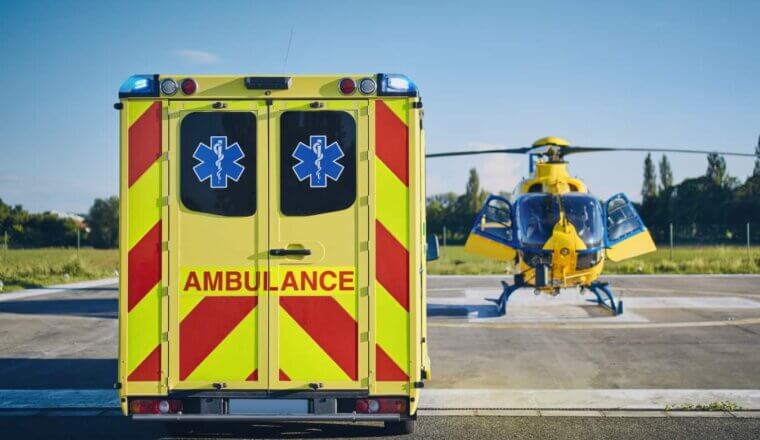
Get my best stuff sent straight to you!
Pin it on pinterest.

DIY: A Travel Medicine Kit Checklist That Fits in Your Carry On
This post may contain affiliate links. As an Amazon Associate I earn from qualifying purchases.
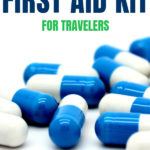
A travel medicine kit is an essential part of packing. Getting sick on vacation is miserable , but sooner or later, it happens to everyone. I seem to get hit with a bad cold every year while traveling (those darn airplane germs!) and my husband is so sensitive to stomach issues we call him “the canary in the coal mine”.
The good news is that it’s remarkably easy to find just about any medication anywhere in the world — but it often takes a big chunk of time, especially if you’re staying in small towns or rural areas where you have to drive a long distance to the nearest pharmacy. And take my word that you don’t want to get food poisoning at 1am and have to wait until morning for a store to open to get supplies.
The faster you can solve your problem, the better. But unlike Mary Poppins, I can’t carry everything all the time — there has to be a balance between having enough to be useful without weighing you down.
After tons of travel, I’ve created a comprehensive, mini first aid kit. This DIY first aid kit is quick and cheap to make plus has all the essentials. When you’re not traveling, throw it in your day bag for local adventures or keep it in your car so it’s always handy.
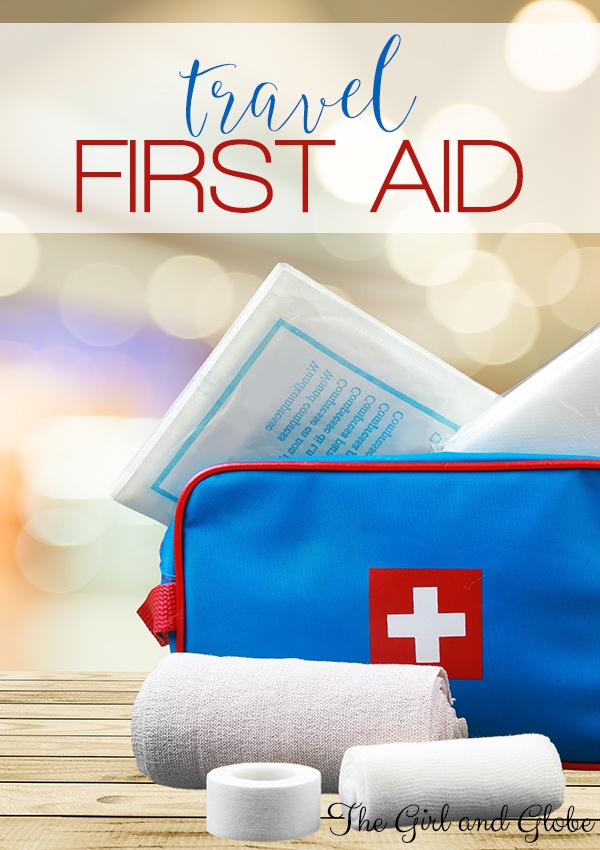
Travel Medicine Kit Basics
Although you can buy a pre-packaged travel emergency kit, I recommend tailoring it to your specific needs. That way you’re 100% familiar with what’s in it ahead of time and have products you trust.
Generally speaking, there are three sets of items that should be on your travel first aid kit list:
- Medications You Definitely Need (prescriptions you use at home on a regular basis + special medications for your destination, such as something to help with altitude sickness)
- First Aid Items You Commonly Use (in my case, that’s band-aids for a myriad of adventure activities + ibuprofen as the “all-purpose drug” for fevers, muscle soreness, and headaches)
- Items You Can’t Get Easily at Your Destination (I include items I’ll want immediately in this category; i.e. anti-diarrheals, so you can solve the problem at 3am instead of running to a store)
Your first aid packing list might change a little for every trip. You can take just the necessities for a weekend in New York City but will need a more comprehensive first aid kit for remote destinations.
Organizing Non-Prescription Medications
No one wants to pack a dozen pill bottles in their carry-on! Besides, it’s highly unlikely you’ll need all 200 aspirin! Better to condense a 2-3 day supply into a more compact case. That’s likely all you’ll need — if that! — but in any case, it’s at least enough to buy you time into you can restock during your trip.
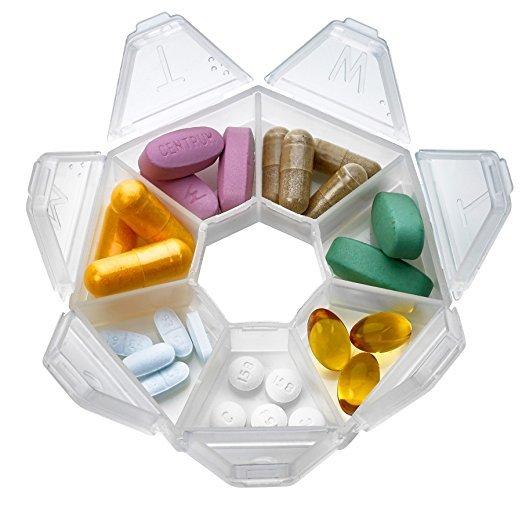
That’s why I use a standard 7-day pill case to organize my over-the-counter medication. Instead of using each compartment for one day’s worth of pills, I use each space for a single type of medicine. So, for example, Monday will hold ibuprofen and Tuesday will hold allergy meds.
Just be sure to label, either by writing with a Sharpie marker right on the case or taping a legend to the back.
I’m sure you can find these pill organizers at your local pharmacy, or you can order a basic pill case on Amazon .
These are the 7 medications I divide in my organizer, although you can tweak it for your own travels:
- Ibuprofen (I prefer it for pain relief but you could easily substitute Tylenol or aspirin)
- Decongestants (after ibuprofen, this is the most reached-for drug I pack; airplanes are a hotbed for germs!)
- Antihistamines
- Anti-diarrheal
- Antacids or indigestion meds
- Motion sickness meds
- For me, it’s lactaid, but this is also a great spot for vitamins or probiotics
Pick the Perfect Bag
My first aid kit is about the size of a paperback book, giving me enough space to work with without weighing me down. I keep it stocked with essentials so I can “grab and go” for most trips without having to worry about a last-minute supply run.

First Aid Kit Supplies:
- My over-the-counter pill box
- Bandages (I prefer ones with built-in antibiotic cream for convenience)
- Antiseptic wipes for minor cuts
- Throat lozenges
- All-purpose first aid balm (hint: Green Goo works great for bites and stings, is all-natural, and the TSA considers it a solid for packing purposes)
- Moleskins for blisters
- Oral rehydration salts – for cases of food poisoning, over-exhertion, or one too many late nights
- Ginger chews (for nausea)
For those of you thinking this is overkill, yes, you can buy premade kits. Here’s the problem: the cheap ones are worthless: you’ll get bandages that don’t stick and so few pills that you’ll be replenishing them after one trip anyway. And you’ll likely get a few medications you’ve never tried before, which would make me really nervous if I was far from a hospital.
The best travel first aid kit is made by Adventure Medical. It’s crazy comprehensive and probably bulkier than need be, but I trust all the medical supplies in it. (Making your own will be cheaper, but obviously not as easy).
Don’t Overstuff Your First Aid Kit Contents
I don’t bother packing items that I don’t use at home, but if these are more common in your household medicine cabinet, you might want to bring them with you while traveling:
- Medical equipment you may need (i.e. syringes, inhalers, epi-pens)
- Aloe wipes or other sun relief items (I may not bring aloe, but I do pack sunscreen!)
- Multi-vitamins and other nutritional supplements
- Antifungal gels or creams
- Separate antibacterial ointment
- Disposable gloves
- Elastic bandage wrap
- Thermometer
- Medical Tape
Remember you don’t need a lifetime supply of everything, so count out what you’ll most likely need and leave the rest at home. I find small GoTubbs to be a good size for packing specialty items.
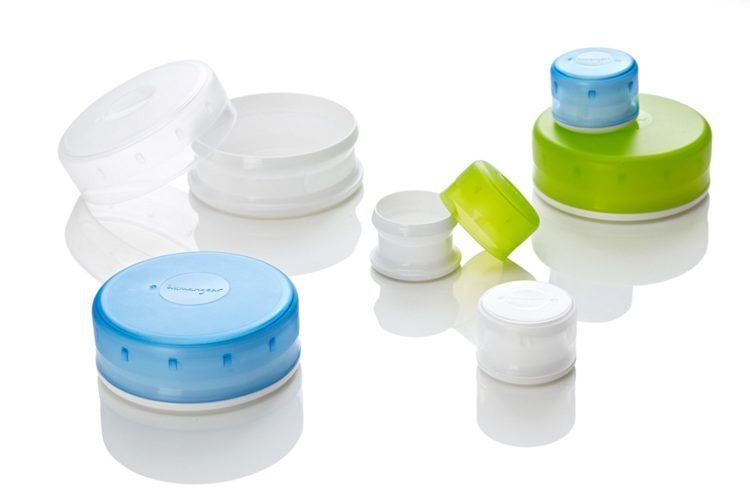
Be Smart About Your Travel Health Your first aid packing list is just one piece of the travel health puzzle. Particularly when traveling abroad, you should start by researching if there are any diseases that are common in that area. The CDC has an official traveler health resource to get you started on things like zika virus, malaria zones, etc. (although I find the UK version easier to navigate). For many destinations, especially in tropical countries and/or developing nations, you may also need to ask your doctor about travel vaccines. Read my complete guide to budgeting for travel immunizations . Lastly, it’s always a smart idea to purchase travel insurance which will help cover health care costs if you seek medical treatment abroad or if you need emergency help. I always purchase through RoamRight , but no matter who you choose, you should educate yourself about policy options .
The Most Important Tips for Your Travel Medical Kit
If you’ve got safe drinking water and health insurance and wash your hands often, that’ll get you most of the way there.
My last piece of advice when it comes to a travel first aid kit is to make sure it’s accessible! If you get a headache onboard an overnight flight but your first aid kit is in your checked suitcase, it does you no good.
Make sure what you need is easy to get to when you need it. That’s a mistake I’ll only make once!
* * *
DIY Travel First Aid Kit List
A first aid kit prepares you for illness, common injuries, and minor accidents. Homemade first aid kits can pack small to fit in suitcases, purses, or cars.
Instructions
Divide over-the-counter medications into small dosages to save on space.
I recommend restocking when you get home from a trip so you're ready to "grab and go" when you pack for the next one!
Recommended Products
As an Amazon Associate and member of other affiliate programs, I earn from qualifying purchases.
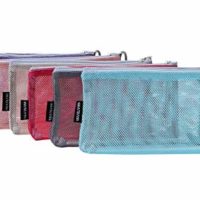
What’s in your travel medicine kit?
Is there something different in your carry-on first aid kit? Do you have other travel tips?
22 thoughts on “DIY: A Travel Medicine Kit Checklist That Fits in Your Carry On”
On every leg of air travel I wear a new paper mask covering nose and mouth. I put it on as soon as the plane doors close, removing it just long enough to eat and drink. Two reasons: 1- So I don’t catch the cold other travelers have; 2- Because the air is so dry on planes, I appreciate being my own humidifier.
Sounds like the perfect size kit. I travel with very little because I tend to purchase meds if I need them at my destination, but anti-diarrhea meds and nausea medications are two that I ALWAYS have with me. Since I lead tours, I can’t be feeling too ill to go out with the group! Those two things usually get me through the day, no matter how sick I am and then I can spend the night in the bathroom if need be, lol.
Before traveling, we prepare our bag with some essential things which we think can be used in journey and first aid bag with proper medication tools is one of those essential things, Make a list of all tools and check before leaving whether all tools present on the list are in the first aid bag or not, I think all tools mentioned in the above post cover everything, but I like the idea of bringing new paper mask, thanks céline bouchard for mentioning this idea in your comment.
Hi can I buy your bag?
@Sabina, What bag do you want to buy? You can make your own easily!
I also bring small scissors to cut the moleskin. One thing about first aid packing that is such a pain is the common recommendation to bring all prescription medications in their original containers, particularly for international travel. On the one hand, that is the safest in case you were to be detained or questioned, but on the other, it adds a lot of bulk to packing that otherwise could be reduced in size. What are your thoughts on that?
@LeRainDrop, Almost everyone I know packs their prescription meds in a pill box rather than original containers. I’d bring a paper detailing meds/dosages + physician’s name and phone number, just in case. (I’d be MORE conservative if you have highly controlled substances, like pain meds)
Thank you so much! I have a handful of prescriptions but no controlled substances, and I got the comprehensive letter from my doctor detailing all my medicines. I wish I found your site earlier, as I’m packing right now for an extended trip to Guatemala in two days, and your site provides a great wealth of info!
Thsis is great info. I’m packing for a trip right now, and will be including these items in my bag for sure.
This is a great list! I never leave home without a fully stocked first aid kit. You never know when the kids are going to hurt themselves.
@Audrey, Or the adults 😉
My wife is responsible for the kit in our family. I’m glad she is, I would have forgotten half of these things!
@Scott, I’d forget too without a list…
Great idea. I never seem to have the right things when I pack. Now I can just use your list and be prepared when we travel. .
Hi Becky, It was great to meet you at WITS17 this year. I always make sure that we have a first aid kit in our car, since we have four children and an accident prone dad of the house!
@Natasha, Pleasure to meet you also…great conference! Funny how sometimes it’s the parents who are more accident prone than the kids.
This is not exactly gear but: Don’t forget to call your wireless carrier to find out what options it offers for traveling wherever you are going. Accidental roaming can be very expensive, and most carriers offer options that are much more economical.
@Paula, Totally true! It’s best to have a set plan that works in your budget or buy a local sim card on arrival.
Pingback: 5 Easy Tricks for Making Your Summer Travel Less Stressful (Hint: Wine is NOT on the List) – A Third Life Crisis
I totally agree with you in that the things you need to pack in your first aid kit will depend on the place where you are going. It is important to understand what type of dangers you might be exposed to in order to have the best supplies on hand to avoid any serious accidents. We are planning on taking a camping trip in a few days and wanted to make sure we had the best first aid kit for the job, so I’m glad I found your page.
@Marcus, Hope your adventure was a success!
Excellent and honest post. I found this much useful information, as to what I was exactly searching for packing tips. Thanks for such post and please keep it up.
Leave a Comment Cancel Reply
Your email address will not be published. Required fields are marked *
Writing From Nowhere

Just In Case Travel Kit List (19 Essentials)
- June 5, 2021
- 16 Comments
Most of the *ultimate travel packing lists* focus on the fun parts of travel. The bags, the gear; the stuff that’s exciting to think about and buy. This travel kit list is full of the other stuff you need to take traveling. Consider this your just in case travel kit that everyone hopes they won’t ever need.
But, that doesn’t mean it can’t be fun! Whether you’re backpacking, on a road trip, city-hopping or traveling full-time, these are the essentials for your travel packing checklist.
This emergency travel packing list will help you to be more prepared, resilient and result in a more enjoyable trip. I affectionately call this just in case travel kit my travel “headquarters,” and it has saved the day countless times. Pack the items on this travel kit list, and I’m sure it will bail you out, too.
Taking time for travel preparedness isn’t just good common sense, but it’s also an essential part of being a more sustainable traveler . Being able to repair a buckle or mend a shirt mid-trip will reduce your need to purchase new gear. If you have the means to fix things when they break, you save items from the landfill and also the resources and carbon footprint of buying a new product to replace it.
Extending the life of your gear stops you from having to send your old gear to the landfill, and also saves you money. Being prepared for traveling is a win all around!
This is my personal travel emergency kit list, and you’ll probably be able to tell that I love being prepared. If you’re thinking about the just-in-case items you need for a trip, use my travel kit list as a guide and take or leave items as they suit you.
Let’s get right into the travel essential packing list that will help you be prepared for whatever travel throws at you.
Pause now and pin for later!
Just In Case Personal Items

1. Vomit bag
I truly hope you’ll never need this vomit bag, but if you feel even a little queasy you’ll be so thankful to have on hand. No trip packing list is complete without this.
Just because you’ve never been motion sick doesn’t mean that it will never happen. Personally, I’ve never been car sick in my entire life, until riding in a van up tiny hairpin roads through high elevation in Peru. The changing altitude got to me, and I’ve never felt that sick to my stomach in my life.
Remember that food is also a wild card – your stomach may not be used to the cuisine wherever you are, plus not every country has laws around food ( “does this taste old to you?” ).
I met a Canadian man who had been vomited on while traveling – by people he didn’t know – twice. TWICE! * shudders * Let’s all agree to carry vomit bags so that if we cross paths somewhere in the world, we don’t accidentally puke on each other.

Beyond your just in case travel kit, I actually recommend you sneak a vomit big into your messenger bag, bookbag, purse, etc. for daily emergencies. It takes up no space, but if it’s needed, it will save the day.
Any paper bag will do. If you’ll be flying for your next trip, take some from the plane. Vomit bags should be in the seat-back pockets or you can ask a flight attendant.

2. Dramamine
You need this item in your travel kit list for the same reasons as the vomit bag. Just remember to store it somewhere reachable , not in a bag that you’ll be stowing away under the bus, train , or aircraft.
Anyone who is prone to motion sickness pack a bottle in their just in case travel kit. For the rest of us blessedly strong stomachs, just take a few tablets as a backup.

Dramamine Chewable Tablets – 8 Pack on Amazon
3. Toilet paper
Not all countries provide free toilet paper in bathrooms like a lot of us are used to.
Even in the US, I’ve seen some pretty ragged rest stops that weren’t stocked ( I’m looking at you, latrine on the southern border of Arizona that hadn’t seen any love in an unseemly amount of time ).
When you’ve gotta go, you’ve gotta go, toilet paper on hand or not, so be prepared.
If you’re going on a long trip, I would take a whole roll (squish it flat and store it in a ziplock bag to keep it clean). For a smaller trip, enough for emergencies should be fine.
4. Hand sanitizer
It’s not the norm everywhere to wash hands after using the bathroom. I’ve seen many bathrooms that don’t provide soap or have running water.
If it’s your personal norm to do so, then you’re going to want hand sanitizer. Start every trip with a travel-size bottle and buy more along the way if you have to.
Also, if you’re in the position to spend a little bit more money, choose a cruelty-free and vegan hand sanitizer to make a more conscious purchase.

Vegan, Cruelty-Free, Eco-Friendly Hand Sanitizer on Amazon
5. Liquid IV
It takes constant, intentional effort to stay hydrated when you travel. In my humble opinion, conscious hydration is one of those hidden-gem travel trips that can help you really improve your health and wellbeing. Bring a little help in the form of Liquid IV.
Liquid IV is an electrolyte powder that provides rapid hydration. It contains glucose, sodium and potassium that “delivers water and other key nutrients directly to your bloodstream, hydrating you faster and more efficiently than water alone.” (more product specifics can be found here from the company themselves )
This is a miracle powder. Staying intentionally hydrated will make you enjoy traveling more. In particular, this will save you during long-haul bus rides or flights, while hiking, or emergencies like plain old dehydration.
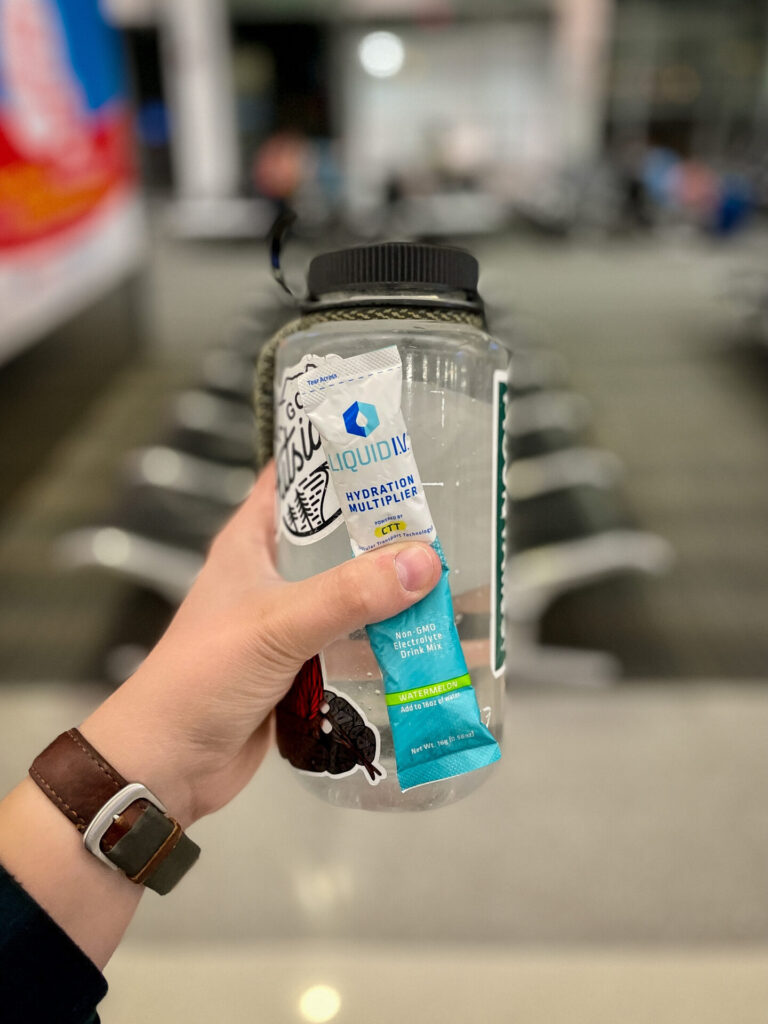
Reflecting on my own travel memories, there are so many times when I know I would’ve felt better and enjoyed my surroundings more if I hadn’t been so dehydrated.
The worst offender was a long bus ride from Lima to Cusco in Peru. It was supposed to be about 18 hours, and usually, buses make stops along the way. This bus, for whatever reason, didn’t. And there had been a landslide which required the bus to slow down and carefully drive over the rubble, so instead of 18 hours, this bus ride took 27.
I only had one bottle of water on the trip, and I felt so deeply *wrong* by the time we arrived. I only peed once in 27 hours. Not drinking water or using the bathroom makes you feel terrible and has health implications.
Tuck a few Liquid IVs into your just in case travel kit and you’ll be happy you have them.

Liquid I.V. Hydration Multiplier Electrolyte Powder on Amazon
6. First Aid Kit
There are two types of first aid kits you should have for traveling. The first is a small kit for shorter trips, or for traveling in places where you’ll never be far from help. For example, it’s probably overkill to pack a splint for just a weekend in Paris, where help could arrive very quickly if an accident were to occur.
I am not a certified first aid expert, so you should consult the American Red Cross’s recommendations for further safety information.
First Aid Items For Short Trips
What I recommend: take a full first aid kit on long trips, but for a week or less, just take the basics ( except for outdoors-focused trips, in which case you should always take a fully loaded first aid kit ).
Here are some health-focused items for your travel kit:
- Multiple sizes of bandaids
- BleedStop , a powder that you pour into cuts or wounds to stop bleeding
- Alcohol cleansing pads
- Benadryl to treat allergies and itches
- Moleskin for blisters
- Antibiotic ointment for treating cuts, burns and reducing the risk of infection
- Bandage tape
- Liquid IV (for dehydration, diarrhea/food poisoning, etc.)
- Wound closures – this may sound intense, but they’re so tiny and they work so well at closing cuts
- Small scissors – for cutting gauze, Moleskin, or (in extreme cases) clothes off
First Aid Items For Long Trips
Just so you know: this list does not include every single first aid item you should include on your travel kit list. My kit has more than 100 pieces in it, and this is just covering the highlights. You should refer to the American Red Cross for professional advice. Especially if you’ll be in a scenario where help would be delayed ( such as on a boat, in the backcountry, etc. ).
- Medical gloves
- Surgical mask – you can buy these in the first aid section of most stores, or even get them for free during flu season. If you’re going anywhere with volcanoes or a chance of earthquakes or wildfires, you should take one. Filling your lungs with ash or dust is painful and damaging. Individually-wrapped is best
- A Sam Splint for stabilizing sprains and bone breaks
- Foil thermal blanket
- Instant ice pack
- A Sharpie for extreme scenarios in the backcountry. In the event that two people are in the backcountry together and one of them incurs a life-threatening injury and is unable to move, their partner may have to leave them to seek out help. A Sharpie is used to write information on the injured person, in the event that they lose consciousness and are discovered by someone else. If you’re going into the backcountry, you really must prepare by taking the American Red Cross Wilderness And Remote First Aid Course .
Personally, I love first aid and preparedness ( am I the only one? Do you also get a kick out of being prepared?? ). But if this seems like too much work, you can buy a premade safety kit and add any additional pieces yourself to flesh it out.
Pro tip: if you assemble your emergency kit yourself, be sure to opt for travel-size first aid items. It’s not as cost-effective, but larger volumes of liquids will become a hassle going through airport security. You can store everything easily in a small toiletry bag.

163 Piece Waterproof Portable Essential Injuries on Amazon
Just In Case Travel Kit: Practical Items
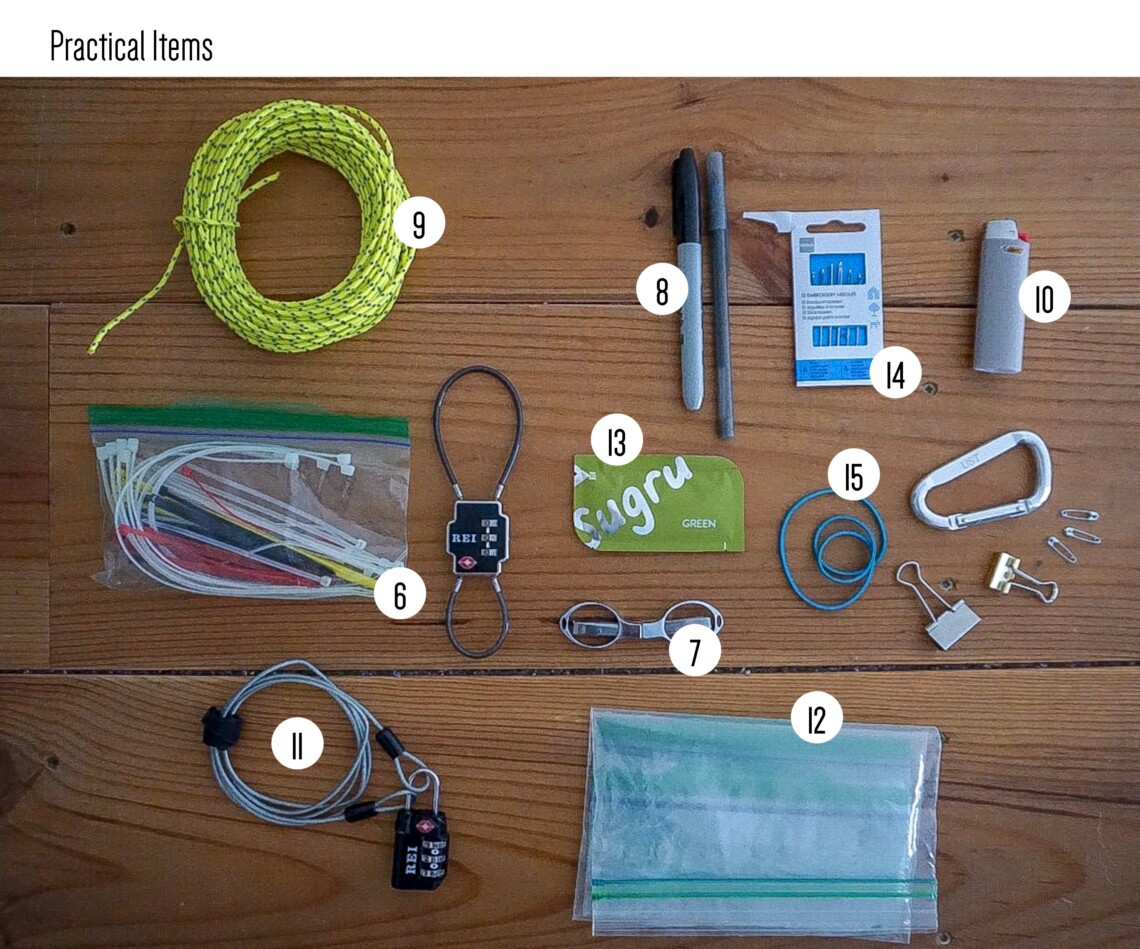
7. Zipties in an assortment of sizes
These are great for MacGyvering broken items.
A zip tie can become a makeshift shoelace, zipper pull, bag handle – you get it. Endlessly handy to have.

Assorted Zipties on Amazon
8. Small scissors
If you take scissors, you will find yourself using them. It’s just one of those things! Personally, I like actual scissors over a pocket knife, but a knife will probably tick this box as well in many situations.
Plus, as I mentioned in #5, scissors are an essential part of a complete first aid kit , useful for cutting clothing, gauze, bandages or Moleskin.

Portable Mini Fold-Up Scissors on Amazon
9. Pen and marker
These might be items you don’t think you’ll need, but if you end up do needing to write something down and don’t have anything, you’re out of luck.
You’ll need a pen to fill out any customs forms if you’re going abroad. A marker is handy for labeling your food in a hostel kitchen.
10. Paracord
Paracord is handy in mending broken items, or making something new altogether – I have 2 friends that built a makeshift tent out of tarp and paracord when they couldn’t find a hostel for the night. For bonus travel preparedness points, consider bringing a roll of reflective paracord . After a camping snafu where I tied up a bear bag in a tree and then couldn’t find it, I now use the reflective paracord to help mark things.
That can be a bear bag, the entrance to the campsite, small items that are easily overlooked and left behind when packing.
When doing a lot of bus travel, it can also be handy to tie reflective paracord to backpack . This makes it easy to spot when unloading a bus in the middle of the night or trying to describe your bag to the person returning luggage.

Fluorescent Reflective Paracord on Amazon
11. Lighter
Even if you’re not a smoker, it’s just one of those basics that is good to have. If you do smoke or use a lighter often, consider getting an electric lighter and making it the last lighter you’ll ever need.
That’s right, locks plural! I recommend taking two locks on every trip.
Combination Lock and Cable
The first lock that you need in your just in case travel kit is a standard combination lock with a cable . Reduce your odds of being robbed by keeping your backpacks together. This is handy if you have to sleep somewhere public (like an airport) or if you, for some reason, have to leave your bags behind.
By tying bags together, you make it much more unlikely that an opportunist will come up and discretely walk off with your bag.
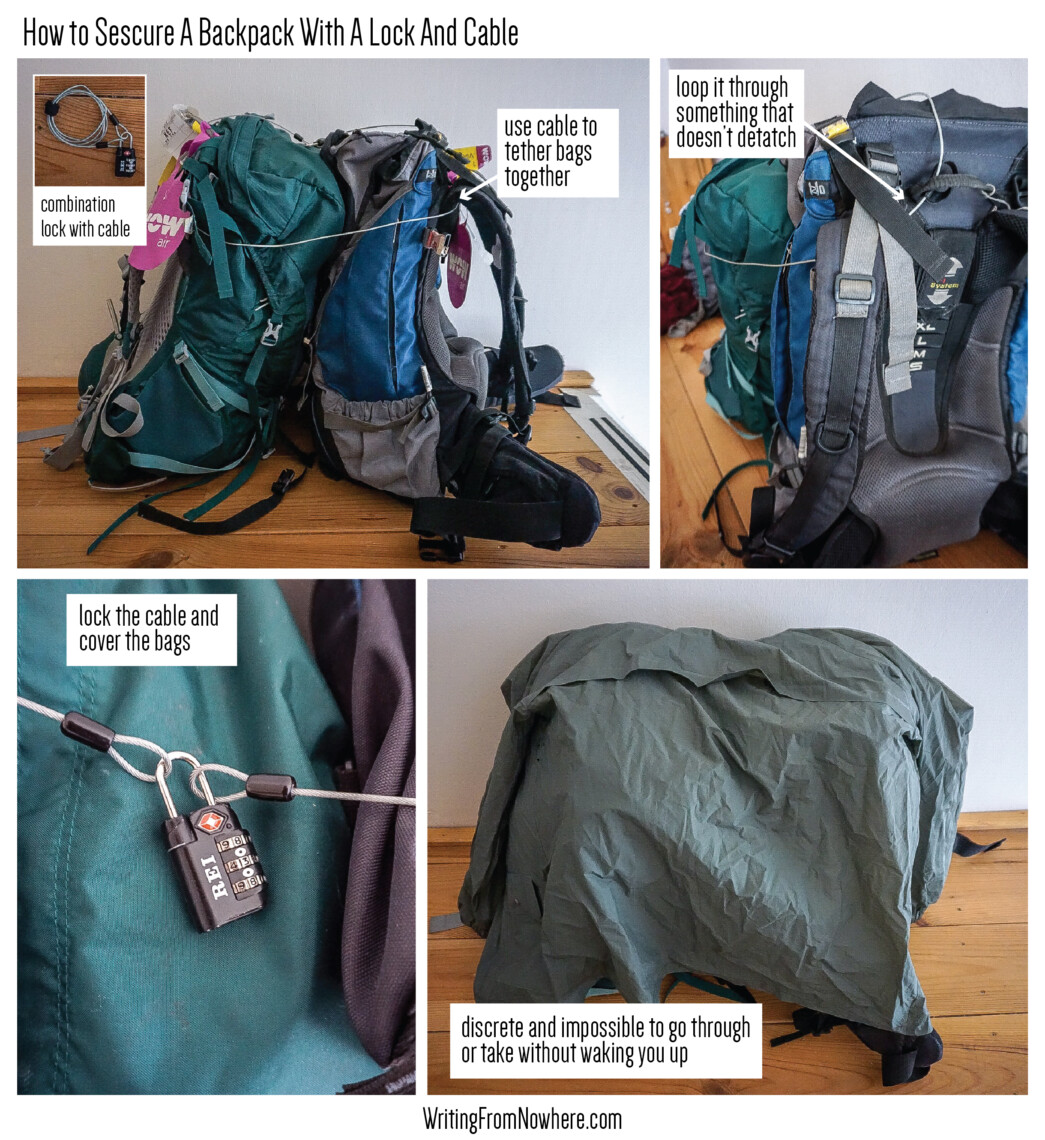
Take a cable lock around both packs, going through zipper pulls or handles to make sure it’s actually connected, then put the ends of the cable on the lock and lock it.
Then, throw a raincoat over the top of the packs for discretion.
If someone came over while you were sleeping, just the sound of pulling the jacket off would probably wake you, but there’d be no way to quickly take off with huge packs tethered together.
This may sound intense to some travelers, but I’ve had my room rummaged through and robbed before so I’ve made it a habit to be proactive. That’s a good quality for anyone who wants to travel long-term .

Combination Lock With Cable on Amazon
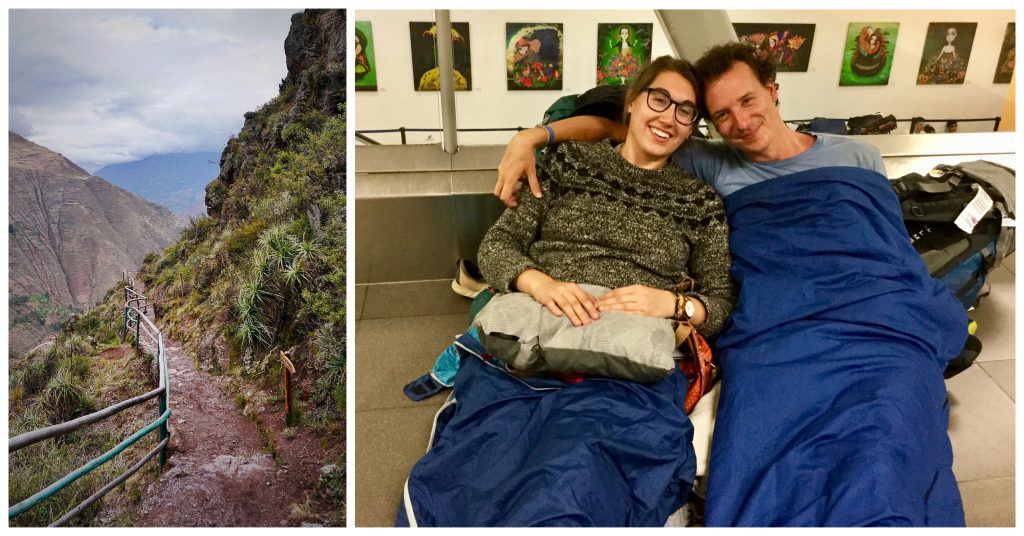
Double-Sided Cable Lock
The second lock you should always include in your just in case travel kit is a double-sided cable lock .
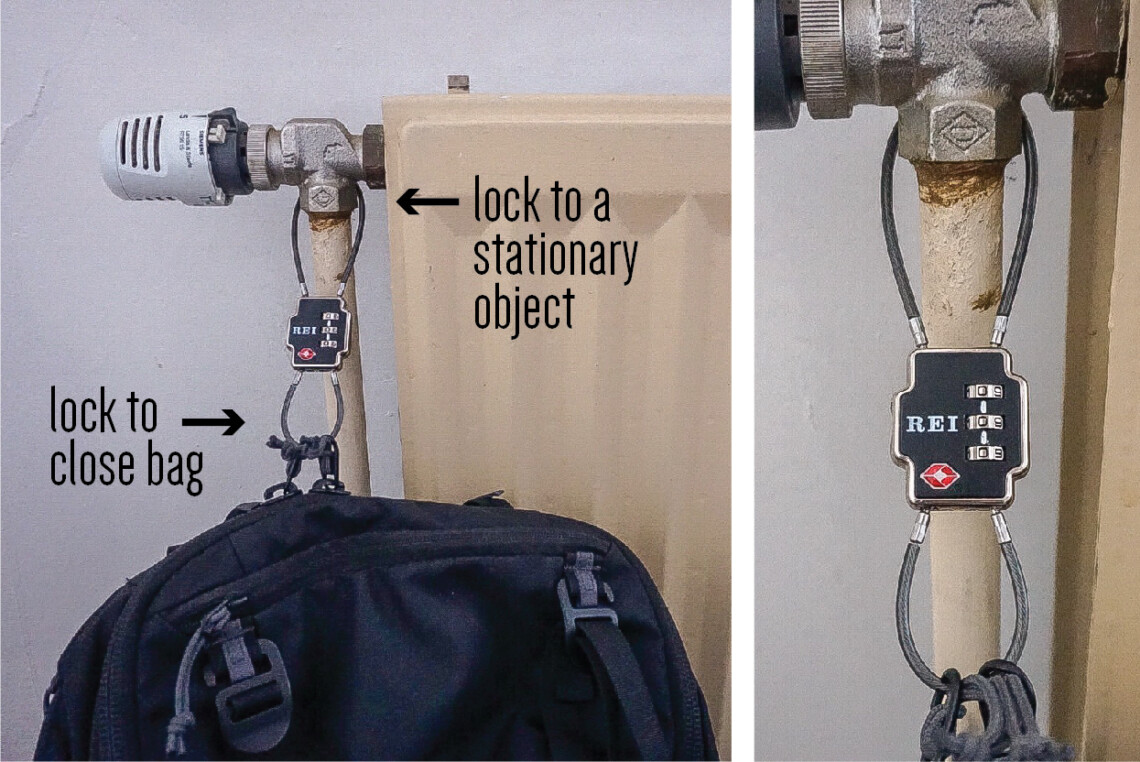
First, you lock your bag shut so no one can go through it. The cable is flexible, so if your bag doesn’t have those luggage pulls with the lock holes in it, you can still get it through.
Next, you lock the longer loop through something else , like your seat or the overhead luggage rack, making it impossible to swipe. With this, no one can rummage through your bag or walk off with it.
With enough time and tools, a thief could still cut your bag, etc. but this is a great deterrence for opportunists.
You can find a double-sided cable lock here . If you’d like more on this topic, I have an entire blog piece on just securing your packs .

Lewis N. Clark Lockdown Triple Security Double-Sided Cable Lock on Amazon
13. Ziplock bags in an assortment of sizes
In your day-to-day life, it’s best to avoid Ziplock bags because of the plastic epidemic, but they’re invaluable when on the road. Take an assortment of sizes.
Some of the best uses : water bag to seal off your electronics during a rainstorm, taking food to-go, “packing out” toilet paper if you’re going to the bathroom in the woods, keeping your liquid toiletries separate from everything else in your bag in case something leaks. That list goes on and on.
You don’t need anything fancy, just something that could maybe repair a broken plastic piece of your pack or reattach the bottom of your shoe.
It’s an unusual travel accessory, but Sugru glue is the glue for the job. It’s super versatile: it’s flexible, mouldable, waterproof and small to carry with you.

This glue is so amazing that I even included it on my holiday gift guide . Glue is a ~super cool~ gift when it does THIS much!

Sugru All-Purpose Adhesive on Amazon
Pro tip: if you add another type of glue to your travel kit list, be sure to store it in a little Ziplock bag. Sugru is individually wrapped, but a liquid glue that’s just in a tube presents a leakage risk. That would be disastrous!
15. Mini sewing kit
This is worth its weight in gold if (when) you a tear in your clothes. You don’t need to be a skilled seamstress, just being able to sew up a hole or reattach a button is immensely useful and can save you from needing to buy new clothes.

Compact Sewing Kit For Travelers on Amazon
16. Rain Gear For You And Your Backpack
“What do weathermen and politicians have in common? They both get paid to lie.” My grandfather told me that joke probably a thousand times while I was growing up.
There’s a lesson to be learned in there though: never rely on the forecast to be accurate.
Your just in case travel kit isn’t ready without some rain gear. It doesn’t have to be bulky or heavy-duty. My rain suit is essentially just a glorified garbage bag, but it’s been keeping me dry for years. I recommend something packable that folds into a little pouch and disappears into your bag until you need it.

Packable Women’s Waterproof Hooded Rain Windbreaker on Amazon
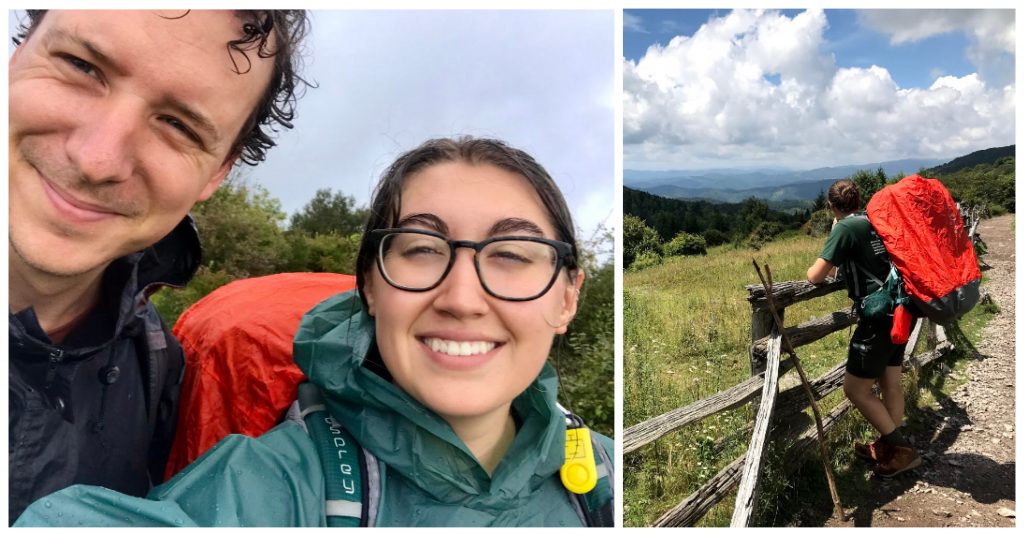
Now that you’re covered, don’t forget your bag! A wet bag is inconvenient, smelly and I reckon expensive if anything gets ruined and needs to be replaced. Your just in case travel kit isn’t ready with a rain cover for your bag as well as your body.

Waterproof Backpack Rain Cover on Amazon
Pro tip: test your raincoat while you still have the opportunity to return it! Make sure it’s truly waterproof, and not just water-resistant. This is particularly important if you’re traveling during a country’s rainy season.
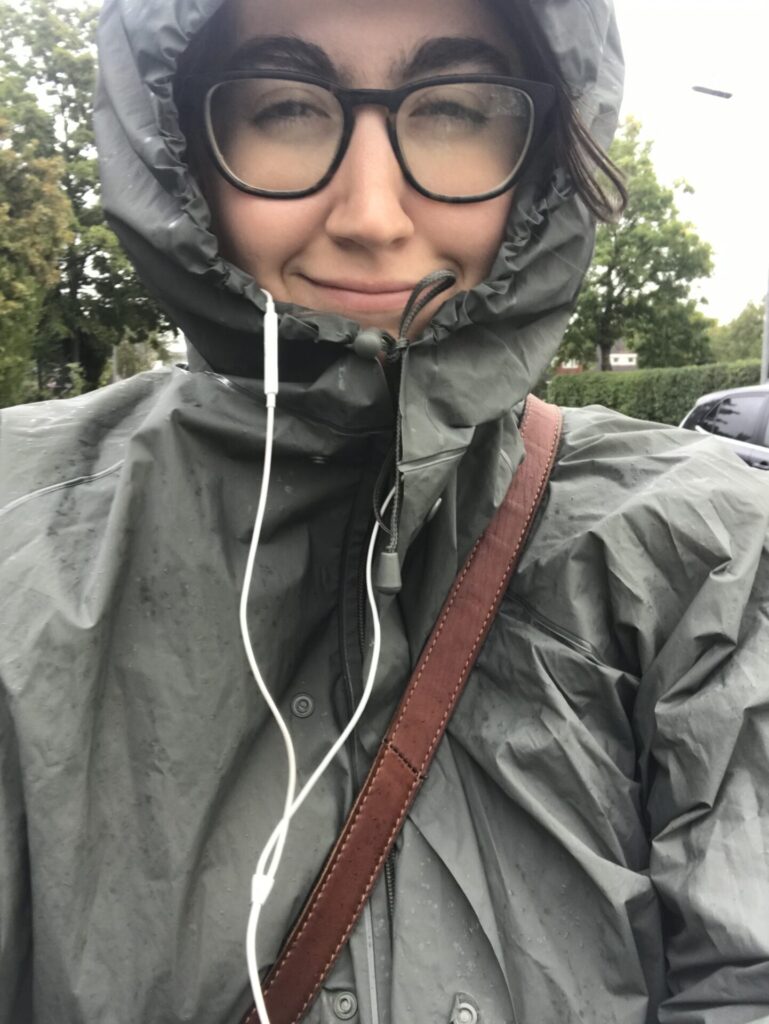
17. Whistle
There are two primary travel and outdoor scenarios where a whistle is extremely valuable.
The first is situations where you’re lost or injured and need to draw attention to yourself. You can blow on a whistle for hours without losing your voice or dehydrating yourself, unlike yelling for help. The internationally recognized distress call is 3 blows of a whistle. If you’re hiking, attach this to the shoulder strap of your backpack so that if you’re injured and unable to move, you can lean to your shoulder and blow the whistle even if you’re trapped or badly injured.
The second is when faced with animal or criminal confrontations. A whistle is like a personal security alarm that will draw attention to your situation. This can potentially scare off criminal encounters or aggressive animals.
In addition to carrying a whistle on your backpacking shoulder strap, carry one in your purse, messenger bag or whatever you always keep on your person while traveling.

Emergency Whistle With Lanyard on Amazon
An exciting step of preparing for traveling is getting the local currency of your exciting destination. In addition to your day-to-day money, you’ll also want to keep a reserve of extra money for emergencies and unexpected situations. Here are 3 steps to take to effectively prepare yourself.
Take a reserve of US dollars for most destinations (except in Europe – it’s unlikely anyone will accept dollars). Not only is the US dollar accepted by many countries worldwide, but it’s also required at some international checkpoints. I learned this the hard way when crossing the border from Honduras to Nicaragua. Neither country used the US dollar as their currency, yet it was the only accepted currency to pay the entry fee with.
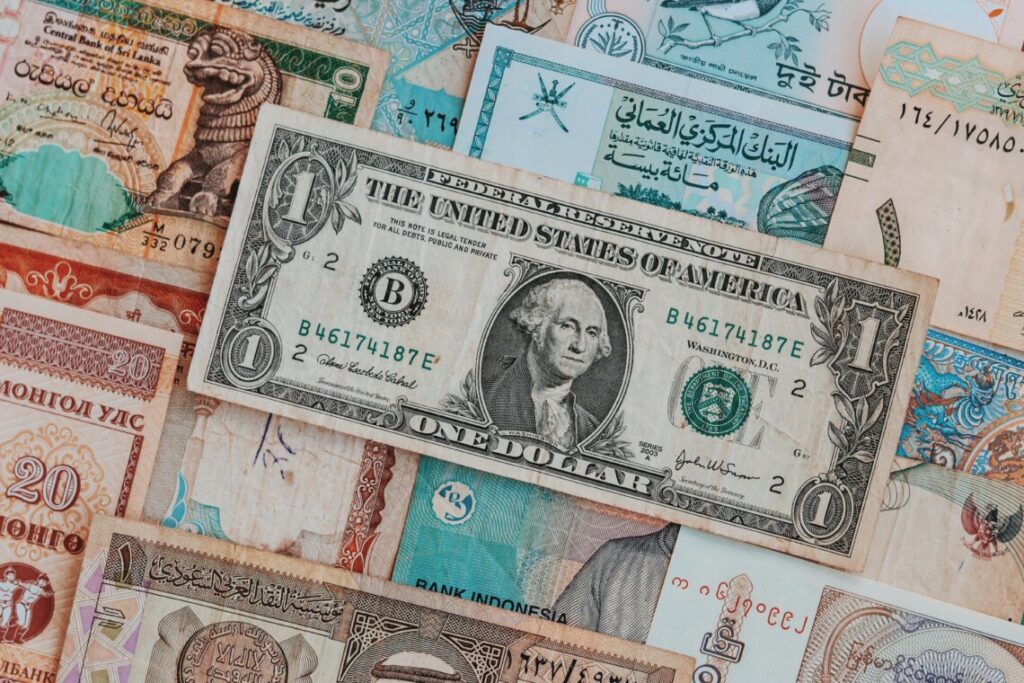
A proactive amount of money to take for 2 people is $300. Don’t take big bills, because you might not be able to get change. Take a division of ones, fives and tens.
Only take clean bills . Bills with writing or tears may very well be rejected because they won’t be accepted by the local banks. American banks will accept anything, but that’s not the case abroad. Whoever is accepting your money also needs to feel confident that it’s not counterfeit, and a dollar bill with a woman’s phone number written on it doesn’t exactly ooze that confidence.
Scatter the bills between your bags , and never carry this around in your day-to-day exploring. You tempt fate when you carry large amounts of cash on you will perusing the streets.
Most people who travel long enough have had their bags rummaged through by opportunists, so make it difficult for someone to find your cash reserve. Split up your money and store it any number of random places in your bag:
- In the toe of your packed shoes, beneath socks and other stored items
- Tucked into your first aid kit
- Taped inside of a notebook
Pro tip: do *not* take big bills. Take an assortment of small bills instead. Getting change for small bills is a common problem in some countries, even for the local currency.
19. Miscellaneous Items For Your Just In Case Travel Kit
These are items that have just come in handy and are small enough to toss in.
- Carabiners in assorted sizes
- Binder clips in assorted sizes
- Rubber bands in assorted sizes
- Safety pins in, you guessed it, assorted sizes!
Don’t pack the whole container of these items, but rather take a few of each out and store them in a small Ziplock bag.
Putting Your Just In Case Travel Kit Together
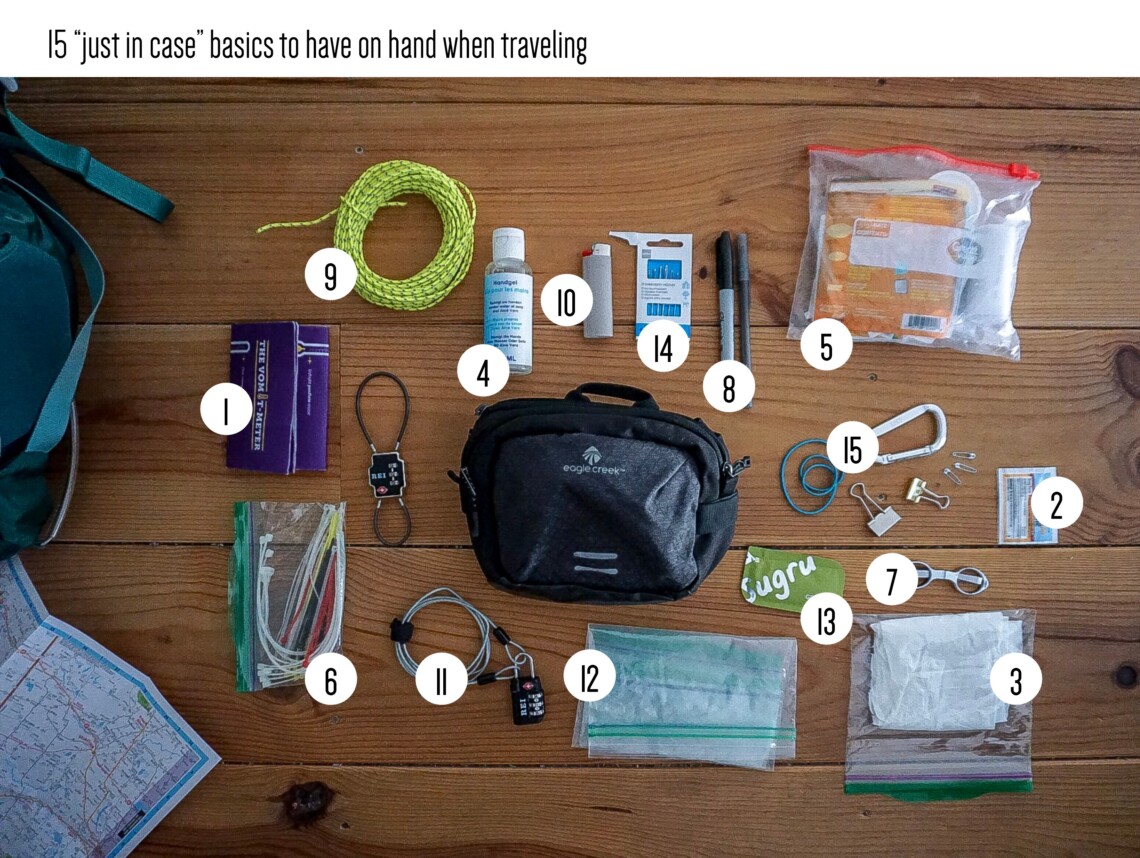
Your travel preparedness items should all be stored together in a pouch or a small packing cube and stored in an accessible area. If you’re traveling with a backpack , keep it in the brain, or the topmost part of your pack, so that it can be easily reached .
On smaller trips with just a day bag, toss this into the abyss of your bag.
Travel Kit List Summary
Do you feel more prepared with this travel kit list in hand? This travel checklist will become your saving grace when you’re on the road, and I’m so thrilled I was able to share it with you.
This list is about more than just providing you ultimate packing tips – it’s about being savvy, staying safe and being resilient to what life on the road throws at you.
What items do you include on your backpacking or vacation packing list? I’d love to hear in the comments!
16 Comments on Just In Case Travel Kit List (19 Essentials)
- Pingback: 4 Things to Pack if You’re Nervous About Overnight Bus or Amtrak Travel – Writing from Nowhere
- Pingback: 2 Techniques For Securing Your Backpack While Traveling – Writing from Nowhere
- Pingback: Honest Amtrak Review: 4 Things You Should Expect – Writing from Nowhere
- Pingback: How to Get Fresh Food While Backpacking or Traveling: 4 Things To Pack – Writing from Nowhere
- Pingback: The Packing List: The Perfect Suitcase for 10 Days in Israel - Donna Colori
- Pingback: The Packing List: The Perfect Suitcase For Travelling 10 Days in Israel - Donna Colori
- Pingback: Lista de Viagem: O Que Levar na Mala Para Israel - Donna Colori
- Pingback: Sustainable Travel Packing List - Writing From Nowhere
incredible! i thought i was reading my list! everything that i have been told is quirky, is on this list. i have everything on my list too! except Sam Splint, Foil thermal blanket,Instant ice pack,A whistle,A Sharpie, possibly casue we are not big hikers. but everything else is there. if i dont use it after 3 trips, an item gets removed. heaven forbid we get Diarrhoea on an overnight trip lol
- Pingback: What To Pack For Pakistan: A Complete Packing List - The Spicy Travel Girl
- Pingback: Full-Time Travel Tips To Sustain The Travel Lifestyle » Writing From Nowhere
- Pingback: Digital Nomad Packing List: All The Digital Nomad Gear You Need » Writing From Nowhere
Thanks for some great advice! I’ve read a lot of posts about packing light, but some light preparedness gear could go a long way!
I am so thrilled you liked it! I also think a little preparedness goes a long in, no matter how minimalist you are!
I really appreciate this post. I have been looking everywhere for this! Thank goodness I found it on Bing. You have made my day! Thx again!
I always carry Tide or Shout wipes just in case I spill food on me .
Leave a Reply Cancel reply
Your email address will not be published. Required fields are marked *
Save my name, email, and website in this browser for the next time I comment.
This site uses Akismet to reduce spam. Learn how your comment data is processed .

- Liechtenstein
- Netherlands
- Switzerland
- Solo Location Guides
- Solo Travel Advice
- Solo Inspiration
- Luxury travel
TRAVEL TIPS & RESOURCES
A pharmacist’s diy travel medicine kit: pack like a pro.
Let’s face it. A travel medicine bag isn’t many people’s priority when it comes to putting together that all-important packing list.
But it should be. You never know when you might come down with a cough or cold, have a bout of diarrhoea or take a tumble. A good traveller is always prepared.
However, many travellers are unsure as to exactly which products they should pack. So what should you include in a travel medicine kit?
This is where I can help you, both as a frequent traveller and as a healthcare professional.
In the course of many adventures in 70+ countries, I’ve experienced my fair share of sniffles, scrapes and sprains. Fortunately, as a registered pharmacist , I know how to deal with these as they arise.
However, I’ve only been able to manage these minor medical emergencies because I’ve packed the right medicines and first aid items. This travel medical kit has evolved over the years and I have honed my selection of pills and potions to a collection that covers most of the bases.
In this article, I will share the contents of my trusty DIY travel medicine kit and give you expert advice on what you should consider when packing medicines for travel.

Some articles on this website contain affiliate links. This means that I may earn a small commission if you make a purchase through these links. As an Amazon Associate, I earn from qualifying purchases . Read the full disclosure here .
IN THIS ARTICLE
What Should I Pack in my Medicine Bag for Travel?
There is no such thing as a definitive travel medicine kit. Much will depend on your age, gender and medical conditions, your destination, style of travel and your attitude to medicines.
It’s all a question of balance. Whilst you won’t want to lug around a medical kit that a paramedic would be proud of, at the same time you should include essential items to cover your basic healthcare needs and emergencies.
Consider Your Destination and Trip Style When Packing Your Travel Medicine Kit
Consider where you are travelling to, and for how long, when deciding which medicines and first aid items to include in your travel medical kit.
Chances are you will not need an extensive selection of medicines, bandages and gauzes on a flashpacking European city break. However, it’s a different story if you are trekking in the Himalayan foothills where access to doctors and pharmacies isn’t a given.
Heading to a high-altitude destination? If so, then you may want to get your hands on preventative treatment before leaving home.
Travelling to a malaria zone? Then. don’t forget your antimalarial medication.
Consider Your Personal Health Needs When Packing a Travel Medicine Bag
Although this may be blindingly obvious, you should consider your personal health needs when packing for a trip. For example; if you are a woman who suffers from menstrual cramps, include your preferred remedy in your travel medicine kit.
What’s in my DIY Travel Medicine Kit
As a pharmacist, I have honed my collection to one that covers most of the bases, and my medicines fit snugly into a semi-rigid plastic pouch from Muji .
Let’s take a closer look at its contents and why they are included. You can buy all of the medicines in my travel kit over-the-counter in the UK without needing a doctor’s prescription.

Medicine for Travel: Essential Items
Pain killer: paracetamol 500mg .
Paracetamol (acetaminophen if you are American) is a highly effective pain-killer and it also helps to bring down your temperature if you have an infection. I have used it for headaches, for cold and ‘flu symptoms and for – whisper it – hangovers.
Don’t leave home without it.
ANTI-INFLAMMATORY: IBUPROFEN 200MG
Like paracetamol, ibuprofen is a painkiller and can be used in much the same way. However, it is also anti-inflammatory and so is useful for soft tissue injuries (strains and sprains).
Many women prefer it to paracetamol to relieve period pain.
If you have asthma or have had stomach problems (ulcers) you may not be able to use ibuprofen; check with your doctor or pharmacist.
The choice of paracetamol or ibuprofen to treat headaches and to bring down the temperature is entirely up to you.
Many people find that one works better than the other for them. For example, I find paracetamol is usually effective in killing a headache but ibuprofen barely touches it.
ANTIHISTAMINE TABLET
If like me, you suffer from hay fever or have allergies , an antihistamine is an essential part of your travel medicine kit. Antihistamines are also invaluable for relieving itchiness from hives and insect bites , including pesky mozzie bites .
My traveller’s medical kit usually has a strip of whichever antihistamine I have to hand. Usually, this is acrivastine but good alternatives are loratadine or cetirizine , neither of which is likely to make you drowsy.
If you want a sedating antihistamine, go for the older drug, chlorphenamine (chlorpheniramine).
Although antihistamine creams are also available, I am less keen on these. They are not as versatile as tablets, and in rare cases can cause skin sensitisation.
ANTI-INFLAMMATORY CREAM: HYDROCORTISONE CREAM 1%
I always pop a tube of hydrocortisone cream in my travel medicine bag.
Although it is used primarily for eczema – some people find that eating different foods makes their skin condition flare up – it is also excellent at relieving the itchiness of mosquito bites.
You don’t need to use a lot of hydrocortisone cream. Make sure that you apply it in a very thin layer.
DIARRHOEA MEDICINE: LOPERAMIDE 2MG
Think of loperamide (Imodium) as a pharmaceutical cork.
Call it what you like; Delhi Belly, Montezuma’s Revenge, Backdoor Trots. Most of us will have been struck down by travellers’ diarrhoea (TD) , usually at the worst possible time.
Trust me; clenching your buttocks on a long-distance bus journey is not much fun. This is where these little green and grey capsules are worth their weight in gold. They are particularly helpful if you have colicky-type pain.
There is some debate as to whether the use of loperamide prolongs TD by retaining the offending bug. The consensus seems to be to let it all flow out, reserving loperamide for those situations where TD may affect travel plans.
My approach is to do exactly that, reserving the use of loperamide for emergencies; to avoid being caught short on a bus or train journey for example.
Codeine and diphenoxylate/atropine (Lomotil) are alternatives to loperamide but I don’t recommend them as they carry a higher risk of side effects for no great gain. Also, you need a doctor’s prescription for these medicines.
Some people take away antibiotics with them to self-treat. The choice of antibiotic depends on the destination.
You will need a doctor’s prescription. A common antibiotic that travellers include in their medical kit is ciprofloxacin .
REHYDRATION SACHETS
Your priority in treating travel diarrhoea or sickness is to keep hydrated. Therefore, I always pop a couple of rehydration sachets with electrolytes in my traveller’s medical kit.
It goes without saying that the water that you use to reconstitute these sachets should be safe
If you don’t have these sachets to hand you can drink other clear fluids, such as diluted fruit juices, as an alternative.
MOTION SICKNESS TABLETS
For those journeys across switchback mountain passes and across choppy waters, I use cinnarizine (Stugeron) tablets, which do the trick but can cause drowsiness.
Another popular choice is hyoscine hydrobromide (Kwells) but I find that it gives me a dry mouth.
Some people swear by acupressure bands ( Sea-Band ).
Other Items To Consider Putting in your DIY Travel Medicine Bag
Antacid tablets.
Think Gaviscon or Pepto Bismol . For those times when you overindulge in delicious food or have a few extra drinks.
What’s NOT in my Travel Medical Kit
Proprietary cold and flu remedies.
This is polypharmacy at its worst. Proprietary cold and flu medicines are cocktails of unnecessary drugs at sub-therapeutic doses.
Save your money and precious packing space. Just take paracetamol or ibuprofen for cold and ‘flu symptoms. If you feel bunged up, a decongestant such as pseudoephedrine (Sudafed) can be useful.
Expert Tips for Packing Your Travel Medicines
- You don’t need to take vast quantities of these medicines and first aid items; just enough to get by until you can replenish your supplies at a pharmacy or drugstore. For example, I take just a strip or two of tablets
- Choose strips of tablets instead of bottles to save precious packing space.
- For the same reason, remove strips from their boxes. But if you are unfamiliar with how to take the medicine, make sure to keep the instructions.
- Where possible, opt for tablets over liquids, gels and creams.
Travel First Aid Items
Sticking plasters (band-aids).
A few sticking plasters of different sizes are an essential component of my travel medicine kit.
The most common injuries are cuts and grazes and you don’t need to be an ardent trekker for blisters to appear.
CREPE BANDAGE
But what about if your injury is bigger than a small cut or graze?
A bog-standard crepe bandage is invaluable for keeping a small dressing in place until you get it looked at by a healthcare professional.
Gauze is one of the most useful items in your travel first aid kit.
A gauze square can be used to clean an injury, apply pressure to a wound to help stop bleeding, and dress a small wound. When used as a dressing, it can be held in place by a crepe bandage or surgical tape .
To keep the wound clean and sterile, pack individually wrapped sterile gauze squares.
ANTISEPTIC WIPES
I also always carry a few sealed alcohol wipes for wound cleansing.
ANTIBACTERIAL CREAM
Again, to prevent wounds from becoming infected and to help them heal faster, it’s a good idea to pack an antibacterial cream like Neosporin .
SMALL SCISSORS & TWEEZERS
Both of these items come as standard in most first aid kits and are extremely versatile items to bring with you on your travels.
Scissors are useful for trimming bandages or gauze to the desired dimensions. As well as grooming eyebrows, tweezers can be used to pull out splinters and to extract bits of stone or dirt from a wound.
Is It Worth Buying a Ready-Made Travel First Aid Kit?
For simplicity and for a travel first aid kit that will be packed to perfection, buying a ready-made travel first aid kit is a hassle-free option. You can be assured that the basics will be covered, and your travel healthcare essentials will come in their own sturdy and waterproof bag.
However, what you gain in convenience you lose in the ability to personalise your travel medical kit to your own needs. Also, as you will only include items that are essential for your trip, it’s likely that a DIY travel first aid kit will be cheaper than buying one online.
The Best Ready-Made Travel First Aid Kits
When choosing the best ready-made travel first aid kit, contents, size and weight are the key factors. Whilst you want to make sure you have enough of all of the essential items, you don’t want this to take up too much valuable real estate in your luggage.
Amazon has a good range of travel first aid kits and I’ve picked out the best lightweight and compact travel first aid kits that they have to offer.

Lifesystems Pocket First Aid Kit
Lightweight (100g) and compact first-aid kit that covers the bases for basic first aid.
>>> CHECK PRICE HERE

Mini First Aid Kit
A 92-piece first aid kit that packs a punch for its compact size.

Universal First Aid Kit in Bag
This 100-piece first aid kit is the most comprehensive of the three shown here and weighs in at 380g.
Best Travel Health Resources
Here are my go-to websites for keeping healthy whilst on the road.
- fitfortravel – a free, interactive, resource providing up-to-date information on avoiding illness and staying healthy when travelling abroad.
- TRAVEL HEALTH PRO – a website comprising the travel health resources of the National Travel Health Network and Centre (NaTHNaC), set up by the UK’s Department of Health to protect the health of travellers.
- CDC TRAVELER’S HEALTH – an extensive collection of resources from the US Centers for Disease Control and Prevention.
Travel Medicines: Final Tips From a Healthcare Professional
Think of this list of items for travel ailments, scrapes and bangs as a tool kit, to which you can add or subtract, according to your needs. In addition, you will need to include any prescribed medicines in your travel medicine bag.
Check with your doctor or pharmacist if you have never taken any of the above medications before. Sometimes medicines don’t mix well together – oral contraceptives and antibiotics are good examples of this – and medical conditions or allergies may mean that it is unwise to take a certain medication.
For any injury or illness that cannot be remedied by the contents of your travel medical kit, or that does not respond to self-treatment, you should seek professional medical attention.
Although carrying these basic items will help you to deal with the vast majority of ailments and accidents as a traveller, it is no substitute for comprehensive travel insurance. As a mid-life traveller , I get my travel insurance from Staysure. It offers an excellent level of cover, including that against Covid-19, and has garnered 5-star reviews.
Finally, whilst it’s essential to be prepared, chances are that you will rarely need to use the items in your travel medical kit.
Safe and healthy travels!

About Bridget
Bridget Coleman is a registered pharmacist who has been a passionate traveller for more than 30 years. She has visited 70+ countries, most as a solo traveller.
Articles on this site reflect her first-hand experiences.
To get in touch, email her at [email protected] or follow her on social media.
6 thoughts on “ A Pharmacist’s DIY Travel Medicine Kit: Pack Like a Pro! ”
Great list—thanks!
FYI: if you are traveling to or in India by air, ALL scissors are a no go except in checked bags! That includes those tiny ineffective blunt scissors in mini first aid kits and nail clippers. You WILL be stopped.
And as it happens, they fasten your checked bags shut if you’re flying within India! So you have no knife or scissors, and a sealed bag…
Great tip! Thanks. I’ll add it to the article 🙂
Admiring the time and energy you put into your blog and detailed information you provide.
This is a great list! Thanks!
Thanks. I’m glad you liked it!
This is a fantastic list! Thanks!
Comments are closed.
Get Daily Travel Tips & Deals!
By proceeding, you agree to our Privacy Policy and Terms of Use .
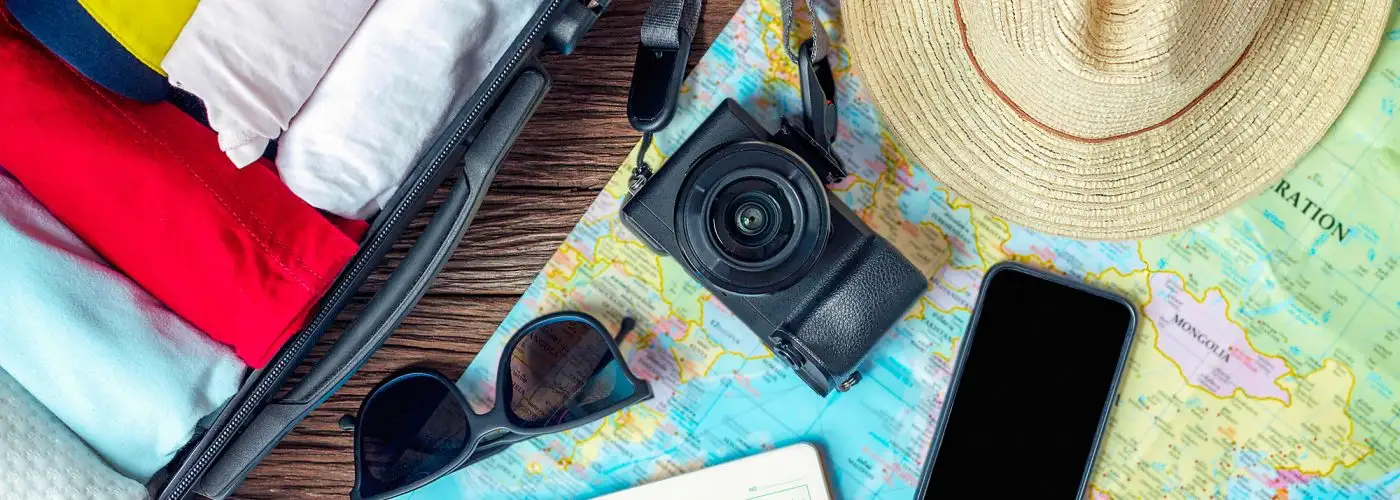
The Ultimate Packing List
Christine Sarkis
Ashley Rossi
There's a 95 percent chance Senior Editor Christine Sarkis is thinking about travel right now. Follow her on Instagram @postcartography and Twitter @ChristineSarkis .
Christine Sarkis is an SATW-award-winning journalist and executive editor at SmarterTravel. Her stories have also appeared on USA Today, Conde Nast Traveler, Huffington Post, and Business Insider. Her advice has been featured in dozens of print and online publications including The New York Times , Conde Nast Traveler , and People magazine. She has also shared travel tips on television and radio shows including Good Morning America, Marketplace, and Here & Now. Her work has been published in the anthologies Spain from a Backpack and The Best Women's Travel Writing 2008 . She is currently working on a travel memoir.
The Handy Item I Always Pack : The Trtl Pillow . It's easy to pack and comfortable, and makes it so I can actually sleep on flights.
Ultimate Bucket List Experience : Seeing the Aurora Borealis from the comfort of somewhere warm, like a glass igloo or hot spring.
Travel Motto : Curiosity is an amazing compass.
Aisle, Window, or Middle Seat : Aisle all the way.
Email Christine Sarkis at [email protected] .
Ashley Rossi is always ready for her next trip. Follow her on Twitter and Instagram for travel tips, destination ideas, and off the beaten path spots.
After interning at SmarterTravel, Ashley joined the team full time in 2015. She's lived on three continents, but still never knows where her next adventure will take her. She's always searching for upcoming destination hotspots, secluded retreats, and hidden gems to share with the world.
Ashley's stories have been featured online on USA Today, Business Insider, TripAdvisor, Huffington Post, Jetsetter, and Yahoo! Travel, as well as other publications.
The Handy Item I Always Pack : "A reusable filtered water bottle—it saves you money, keeps you hydrated, and eliminates waste—win-win."
Ultimate Bucket List Experience : "A week in a bamboo beach hut on India's Andaman Islands."
Travel Motto : "Travel light, often, and in good company."
Aisle, Window, or Middle Seat : "Window—best view in the house."
Travel Smarter! Sign up for our free newsletter.
Packing mishaps range from inconvenient (heading to the Caribbean without a swimsuit) to disastrous (discovering you left the country without your wallet), but most are preventable. We’ve created this ultimate packing list to help you pack well every time.
The Ultimate Packing Checklist
To see the ultimate packing list, scroll down the page or click here for an editable PDF version that you can save or print out. To customize the list, simply download or print it, then edit for your specific needs. You can also download the editable, mobile-friendly checklist here .
Clothes to Pack
- Dress Shirts
- Casual Shirts
- Sweatshirts
- Laundry Kit
- Leisure Shoes
- Hiking Boots
- Dress Shoes
- Collapsible Tote
Shop Our Clothing Packing List
Toiletries to Pack
- Dental Floss
- Conditioner
- Styling Tools
- Facial Cleanser
- Face Lotion
- Moisturizer
- Contact Lenses
- Contact Solution
- Shaving Supplies
- Makeup Remover
- Menstrual Products
- Birth Control/Medication
- Nail Clippers
- Hand Sanitizer
- First-Aid Ointment
- Insect Repellent
- Pain Relievers
Shop Our Toiletries Packing List
Miscellaneous Items
- Laptop/Tablet
- Film/Memory Card
- List of Medications
- Banking Contacts/Information
- Electronic Chargers
- Emergency Contacts
- Copy of Passport
- Plug Adapter
Shop Our Miscellaneous Items List
What to Pack in Your Carry-on
- Books or E-Books
- Travel Blanket
- Travel Pillow
- Disinfecting Wipes
- Change of Clothes
- Empty Water Bottle
- In-Flight Medications
- Passport/Visa/ID
- Credit/ATM cards
- Insurance Cards
- Maps/Directions
Shop Our Carry-On Essentials List
Packing Tips for Clothes and Other Items
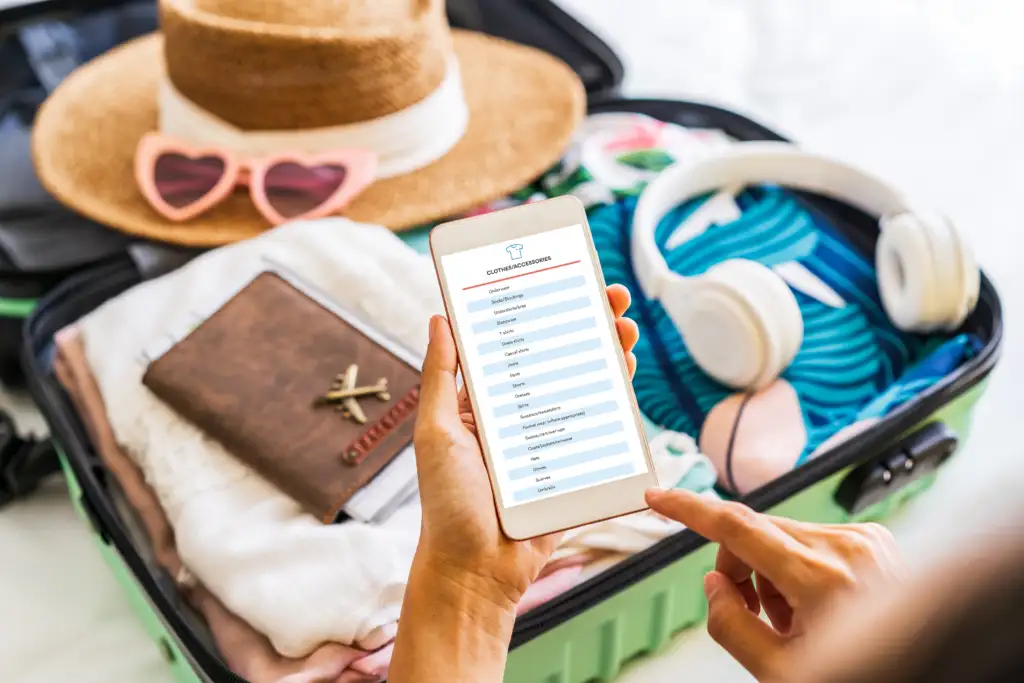
When packing for a vacation the most important things to keep in mind are the length of your trip, the weather, and any non-standard clothing or gear you might need.
Your first step when packing is to decide if you’ll be checking a bag or only taking a carry-on and then curate the amount of clothing you’ll need based on that decision. Typically, you should avoid checking a bag in situations where you have a layover since the likelihood of your bag going missing goes up with every connection . You might also want to avoid checking a bag if you absolutely need items in your bag on arrival—for example, if you’re going on a cruise.
If you’re packing more minimally, focus on packing layering clothes in more neutral colors. That’s not because we don’t like fun colors and patterns; it just means that neutral-colored clothing is more versatile, so you can wear these items more than once when you’re tight on space.
How to Pack in Just a Personal Item Sized Bag
Also invest in clothing that does double duty, like multi-use wraps , crushable hats , self-cooling and heating fabrics like merino wool layers , bug-repellent clothing , wrinkle-resistant shirts, quick-drying activewear and undergarments, casual sneakers, UPF-proof clothing , and compressible jackets … just to name a few. Look toward popular athleisure brands like Lululemon , prAna , and Athleta for comfortable yet stylish travel clothing.
When curating your packing list, you should keep in mind the length of your trip and decide on quantities from there. For a shorter trip (three to five days), you can probably manage with the following: one pair of underwear and socks per day, one pair of pajamas, one to two dressier outfits, one to two activewear or athleisure outfits, one to two casual outfits, and one to two pairs of shoes. For a longer trip (over a week), you can manage with one pair of underwear and socks per day, two pairs of pajamas, three dressier outfits, three to four casual outfits, two pairs of shoes, and two activewear or athleisure outfits.
And if you’re able to do laundry on your vacation, you can probably manage with even fewer items. Just don’t forget to pack a travel laundry kit .
Scrubba Untouched Review
Also make sure to bring along accessories like a money belt, scarf or sarong (can be used for things like an airplane blanket , coverup at the beach, or to throw over your dress on a cool evening), and a collapsible tote or day bag for any extra items you might acquire on your travels. If traveling to a city or destination that is prone to pickpocketing, make sure to pack some pickpocket-proof clothing and gear .
Depending on the type of trip you’re going on, you may need to invest in some special travel gear. We’ve tested out everything from waterproof baby carriers to interchangeable heels , so you can trust our recommendations. If you’re headed out on an organized group tour , you’ll most likely get a packing list from the tour provider, which should make your trip planning easier. If not, do your research online (one tip is to look at locations on Instagram and see what people are wearing) and consult this story for other handy lists of tips.
For more active trips, make sure you have a sturdy pair of hiking boots, quick-drying clothing, a day pack, snacks, and any necessary equipment. Check out our specific packing lists for hiking trips and camping trips .
The 5 Most Crowded National Parks (and Where to Go Instead)
Another type of trip that you may need to pack slightly specific items for is a cruise . Make sure you pack non-standard items like seasickness remedies, formal wear, dress shoes, and your bathing suit. Beach vacations also require different items like water shoes, towels, sunscreen, and maybe even snorkel gear. Luckily for you, we also have a specific cruise packing list and a beach vacation packing list .
Lastly, you need to consider the weather. For warm-weather destinations like jungles and Caribbean islands, you can obviously skip the coats and gloves, but if you’re headed out on a ski vacation then you’ll need a whole slew of things like goggles, a neck gaiter, snow boots, and more. But don’t worry, we’ve got you covered with a specific Caribbean vacation packing list , a Mexico vacation packing list , and even a ski trip packing list .
The Best Ski Hotels in the US
To help keep things organized, we love using packing cubes and/or compression sacks. They’re especially useful for when you’re traveling to multiple destinations in one trip.
Wondering how to pack all of your items? Enter the great debate of the rolling vs. folding method! While this is definitely a personal preference, we put two editors to the test to find out which method is in fact, more space-saving. Watch the video below to see the answer.
How to Pack Toiletries and Medications
Whether it’s important medication or your favorite lipstick, forgetting any type of toiletry can range from being mildly inconvenient to becoming a serious problem. For toiletries, make sure to pack your essentials, like medication, contacts, and any other items that you might not be able to purchase or replace during your travels. (Put them in your carry-on bag, not your checked suitcase.) However, if you forget items like a toothbrush or razor, you can typically call the front desk at the hotel for a spare.
We also recommend traveling with some type of a travel first-aid kit , which includes items like tweezers, first-aid ointment, bandages, travel-sized hand sanitizer, sunscreen, and insect repellent. Make sure to check TSA guidelines if you’re traveling with medication , as well as the policies and regulations at your destination.
Packing Tips for Everything Else …
Traveling without tech items like your phone, laptop, tablet, or camera can be a major bummer. For those traveling abroad, you’ll also want to remember to pack electronic adapters and converters . Other tech-related items for photographers to pack are a sturdy camera bag , backup batteries, and memory cards, as well as lens cleaner. And don’t forget smartphone essentials like a backup charger, waterproof case if you’re headed out on the water, and a phone stand or tripod for photos.
A travel packing tip we’ve learned the hard way? Travel with a copy of your passport, credit card, and bank contacts, as well as a list of medications and your emergency contacts.
If you are traveling abroad, we have an entire checklist for you, but the most important thing to note here is your passport and visas . Make sure that your passport is up to date, has as least six months of validity, and has enough blank pages for any stamps. Another tip for international travel? Give yourself plenty of time to apply for any visas that you might need and to arrange for a visit to a travel clinic if any special medications or vaccines are needed. You should also familiarize yourself with any remaining COVID-19 travel restrictions at your destination.
There are also some items that you may not think to pack, but should, like an electronic tracker , duct tape , toilet paper, a decoy wallet, or a whistle.
The 10 Best Expandable Suitcases
What to Always Pack in Your Carry-on Bag
In case you’re separated from your checked bag or other items, you should always make sure that you have your ID, wallet, house keys, medications, valuables, camera, phone, laptop, tablet, pen, cash and cards, glasses, and copy of your itinerary with you on the plane.
Other items that you might want to have handy with you include entertainment for your flight, comfort-promoting items like a blanket or pillow, as well as an empty water bottle to fill up post-security (here is a list of our favorites ), a change of clothes (just in case your luggage is lost or delayed), snacks, and gum.
If you’re looking to pack carry-on only, you guessed it: We also have a separate packing list and tips for that, as well as the best bags to use for carry-on only .
What to Pack to Stay Healthy While Traveling
The pandemic has significantly changed the way we travel and, by extension, the items we prioritize in our luggage. While many destinations have loosened or entirely lifted COVID-19 restrictions, some venues and events may still require a mask or proof of vaccination/negative COVID test to enter. Plan ahead to see if any activities on your itinerary have restrictions in place.
Sanitizing wipes and hand sanitizer , while always a good idea to have on hand at the airport , have become absolute carry-on musts. Wiping down areas like your tray table, airplane seat armrest, and hotel television remote can spare you from a variety of common travel bugs.
Editor’s note: This story was originally published in 2013. It has been updated to reflect the most current information. Ashley Rossi contributed to this story.
All of the products featured in this story were hand-selected by our travel editors. Some of the links featured in this story are affiliate links, and SmarterTravel may collect a commission (at no cost to you) if you shop through them.
You Might Also Like:
We hand-pick everything we recommend and select items through testing and reviews. Some products are sent to us free of charge with no incentive to offer a favorable review. We offer our unbiased opinions and do not accept compensation to review products. All items are in stock and prices are accurate at the time of publication. If you buy something through our links, we may earn a commission.
Top Fares From

Don't see a fare you like? View all flight deals from your city.
Today's top travel deals.
Brought to you by ShermansTravel
Madrid to Malaga: 8-Nt Southern Spain...

Luxe, 12-Night Spain, France, Monaco &...
Regent Seven Seas Cruises

Ohio: Daily Car Rentals from Cincinnati

Trending on SmarterTravel

Go. Explore.
(480) 435-2774
What to Pack in a Medical Travel Kit
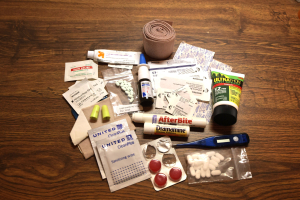
Travelers often ask what they should put in a travel first aid kit or medical kit for travel. Commercial pre-packaged travel first aid kits are available in a variety of sizes, but we think the best option is to assemble your own travel medical kit that suits your personal health needs and travel habits.
It may take a few trips and trials to refine your kit's contents, but then you can keep it all together in one compact package to throw in your luggage at a moment’s notice.
My own “travel health kit” has evolved over time, usually by adding items I wish I’d had on a previous trip. Here are some key considerations and items to include:
Buying medications in foreign countries
Medications, even over-the-counter ones, often have different names or formulations in other countries. To avoid confusion, it’s best to bring familiar medications with you. It's also unlikely that you'll conveniently find a nearby pharmacy with your language spoken, the right product in stock, and open hours when needed. With the booming world trade in counterfeit medications, you want to avoid unknowingly buying a medication that is not effective, or worse can contain harmful ingredients.
Travel Vaccines and Routine Vaccines
Vaccines offer powerful protection against many diseases and should be part of your pre-travel preparation. Consult a travel health expert who can determine which vaccines you may need for your destination.
Do I need any special travel medications?
Some travel specific medications can be required for certain destinations or activities. These can include medications to prevent malaria or altitude sickness (also called prophylaxis). A travel health expert can provide the best guidance and prescriptions specific to your itinerary.
Should I Bring Antibiotics when I travel?
Travelers frequently request “antibiotics just in case”, but the only recommended antibiotic is to treat travelers’ diarrhea (to take as needed only). Other illnesses that you think may need an antibiotic warrant a proper medical evaluation, especially in tropical regions.
Traveling with Prescription Medications
When traveling, ensure your prescription medications are clearly labeled in their original containers. Be careful traveling with controlled substances (like opioids or stimulants), which may be scrutinized and even confiscated in some countries. See your prescriber well in advance of your trip and always carry extra doses in case of unexpected travel delays.
Bring your Medical History Information with you
Carry a legible (laminated if possible) card listing your medical conditions, prescription medications, allergies and any implanted devices. Also include contact information for your primary medical provider and emergency contact(s).
Should I carry an Epi-Pen when I travel?
ALWAYS carry a fresh Epi-pen® (epinephrine injector) with you if you have any serious allergies. Some destinations may not have nearby emergency care available. Also, consider a medical alert bracelet (even if you only use it for travel). If you become seriously injured or unconscious, you may be unable to communicate any serious medical conditions or allergies.
Should I bring my CPAP device when I travel?
If you use a CPAP device for sleep apnea, don’t leave it at home. Fortunately, modern CPAP machines are smaller and more portable. Restful sleep is even more critical when you are traveling or sleeping at an increased altitude.
OTC (over the counter) Pain Relievers
Also known as analgesics, these medications may have unfamiliar names abroad. I suggest packing a small amount of ibuprofen and/or acetaminophen, whichever works better for you. Familiarize yourself with the maximum safe dosage of each.
Loperamide for travelers’ diarrhea
Loperamide (Imodium®) is an essential treatment for travelers’ diarrhea, and a MUST HAVE item for anyone traveling to a resource poor country where you can’t drink the water. Even the local food is sometimes enough to make you “irregular”. Use it cautiously to avoid constipation.
Antacids/Laxatives for travel
An altered eating routine and unfamiliar foods can mess with your digestive tract. Everyone has their own unique gut habits and food tolerances. Personalize choices to your own needs. Chewable bismuth salicylate (Pepto Bismol®) can help with a variety of symptoms, from diarrhea to heartburn.
Cold remedies for traveling
Most mild upper respiratory infections (like a cold) will get better on their own, but the symptoms can be a nuisance. OTC cold preparations are numerous, but I recommend oxymetazoline (generic for Afrin®) nasal spray (DO NOT use for more than 3 or 4 days in a row) and lozenges for sore throat and/or irritating cough. Both can help you get much needed sleep.
Antihistamines
Numerous OTC choices are available and can be helpful if you encounter unfamiliar allergens at your destination or accommodations. Most antihistamines can cause sedation as a side effect, which could be a benefit if you have trouble sleeping on long haul flights.
Medications to Prevent Motion Sickness
Some travelers are prone to motion sickness on boats, in vehicles or even snorkeling or diving. Both prescription and OTC preventive medications are available. See https://www.travelbughealth.com/bugs-blog/medications-to-prevent-and-treat-motion-sickness for more detailed suggestions.
Insect Repellant
Insect repellent is crucial for protection against insect-borne diseases like Malaria or Dengue Fever. Ultrathon® lotion containing DEET is an excellent choice.
Pack only what you need
Don't expect a travel first aid kit to cover every possible emergency; you DON’T need to have every possible thing in it (even if you always pack a prom dress - “just in case”). Plan for likely situations (such as sun, insect bites, terrain, boat rides) and only include things that you regularly use, would grab out of your own medicine cabinet, or have used within the last year. Here are some suggestions:
Essential travel First Aid Kit items
A personal Travel First Aid Kit should include a few basic items to treat minor physical injuries. Don’t go overboard. Minor skin wounds should be cleaned and covered immediately, until you have time to get them treated more thoroughly if needed. Here are some items to consider:
Self-adhesive bandages – Both small and large - have a few of each.
Topical antibiotic ointment – I recommend a small tube of Bacitracin.
Antiseptic wipes - Alcohol swabs are good for disinfecting small scratches or abrasions. I like the disinfectant wipes they hand out on some airlines, which are compact and can effectively clean up a road rash.
Zinc Oxide barrier cream – Think babies’ bottoms and Ozzie surfers. Excellent relief for friction rash from trekking through a wet jungle (personal experience) or an irritated bottom from diarrhea. Also, an effective substitute if you forget your sunscreen.
Compression bandage – Can be used to wrap an ankle, other sprain or even a wound. Find one with Velcro so you don’t need pins or adhesive tape.
Non-stick wound pads - (Telfa®) - Carry a few, preferrably self-adhesive.
Adhesive Blister Prevention tape or pads – Brand names include Moleskin® or Compeed®. KT Tape® (often used by sports trainers and physical therapists) can also work in a pinch.
Sunscreen – Get a travel size. SPF 30 is adequate. Use it.
Post-sunburn cream – Aloe gel preparations can provide good relief and speed healing.
Hydrocortisone cream (OTC 1%) – Offers relief from most itchy rashes.
Afterbite® – A unique product, the size of a makeup pen that provides relief from itchy insect bites.
Tweezers – To remove ticks or splinters. These can be very small and DO pass TSA screening regulations.
Disposable gloves – (bring a handful) They stuff easily and can be useful in so many situations.
Oral rehydration salts – It’s not a bad idea to have a few packets handy if you are visiting a cholera or typhoid endemic area, but if you are losing fluids that fast, you should seek medical treatment.
Small thermometer – Any persistent temperature over 100.4°F (38°C) can indicate a serious illness and should be evaluated by a medical professional.
Other Assorted items for your travel health kit
Ear plugs - Tiny and useful on airplanes and noisy accommodations.
Lubricating eye drops – These are usually very compact and provide instant relief, especially if you’re traveling somewhere dry and windy or wear contact lenses.
Masks – Bring at least 2, just in case. Masks are proven to reduce your chance of airborne illnesses, like from that coughing passenger in the plane seat next to you. A mask can also help you breathe easier in cities with air pollution (think Delhi). Wearing a mask also non-verbally communicates your desire to be kept at a distance. N95 or KN95 (Chinese made equivalent) standard masks work the best.
Condoms - Both men and women should carry them. Don’t laugh. Data shows that travelers are often less inhibited and take more risks when away from home. There is a very high incidence of STDs (sexually transmitted diseases) including hepatitis B and HIV in many regions overseas.
And finally…

Quart-size sealable freezer bags (Ziplok®)
The universal MUST HAVE. I don’t think you can have enough, for many reasons. They are:
- A convenient container for any small items, like collectibles, change, electronics or jewelry (I like to use them beachcombing)
- A neat and convenient lunch bag in a pinch
- The perfect container for your travel health kit items.
- Still the standard for presenting liquids at many airport security checkpoints
- Good for storing wet items or as an extra precaution for containers that could leak in your bags.
An illness or injury can signifcantly impact your travel experience. Think ahead and be prepared with a little bit of knowledge and a few compact items in your travel medical and first aid kit. Visit https://www.travelbughealth.com/ for more travel health tips and advice.
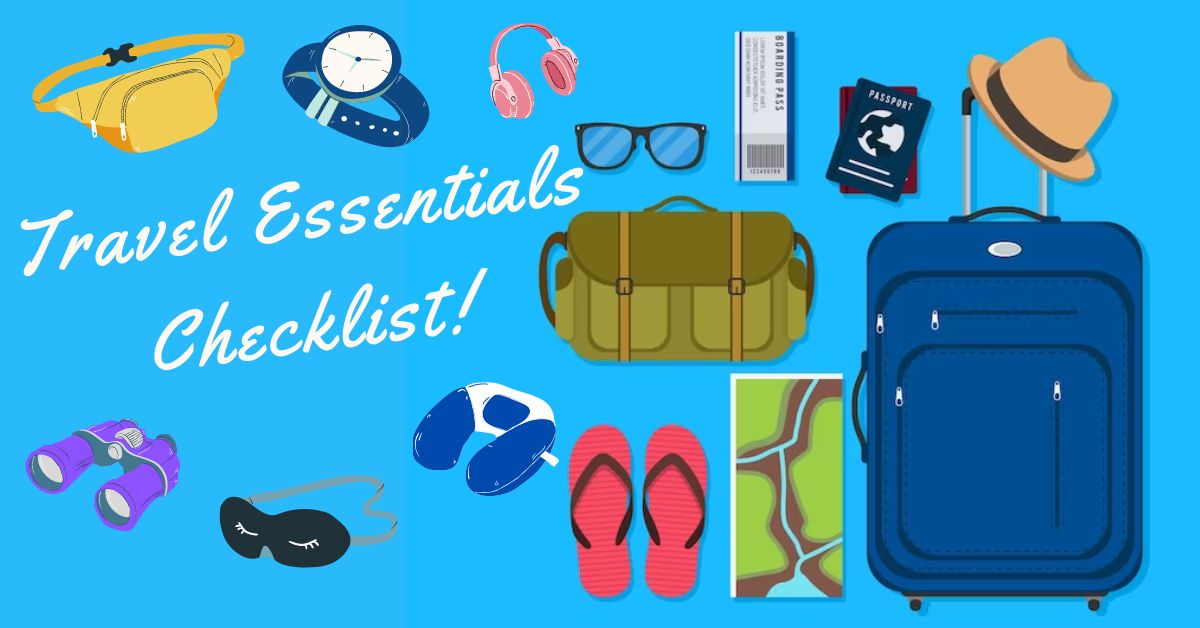
20 Must-Have Travel Kit Essentials: 2023 Backpack Checklist
Priya sharma
Oh, the excitement of traveling! The destination has been decided, the tickets have been bought, the hotel has been reserved, the shopping has been completed, and the only thing left to do is the packing.
Packing luggage before a vacation is enjoyable for some but may be difficult for others. You get your favorite outfits and the new ones you got, especially for this vacation.
When preparing for a trip, it’s crucial to pack your travel kit essentials, including items like toiletries, medications, and chargers. Your travel needs will vary depending on your location, but there are a few items that you will require regardless of where you go.
This article will give you the complete list of travel bag pack essentials, so continue reading to know more. Our essential travel packing list can help you organize and pack everything you need for a smooth and enjoyable trip.
Setting off on a trip, whether it’s a quick getaway or a big adventure, having a ready travel kit is super important. It’s like your secret to feeling comfy, secure, and happy during your journey. But what exactly should be in this special kit? Here are the important things that should always be in your travel kit.
1. Best Comfortable Clothes-
Keep the destination in mind when you search for clothes for your vacation. You will need different clothing for a place covered in snow and one covered with beaches. Pack cardigans, sweaters, and other winter clothing when traveling somewhere chilly.
Aside from your checked luggage, pack a few wardrobe items in your cabin bag, such as a cardigan, cap, a pair of comfy T-shirts, and shorts. It’s always a good idea to be prepared if the airline misplaces your bags or another bad scenario occurs.
2. Travel Wallet-
A travel wallet must have important things like money, cards, and travel documents all in one safe place. It usually has extra pockets and spaces to keep things organized. You can keep your passport, tickets, credit cards, and even some cash in it. Use it to keep track of all your critical papers, such as the passport, AADHAR card, and travel tickets.
Along with the documents, you may use them to store currencies, debit and credit cards, hotel key cards, and various other items.
3. Toiletries-
When we’re away from home, certain things make us feel good. When traveling, having your toiletry pack on hand to help you clean up and feel better might be the distinction between a pleasant and unpleasant journey.
So, carry everything you need in a large toiletry bag. While you should pick up minor goods at your location, some skincare, personal care, and other amenities may be difficult to locate while traveling abroad.
Keep a modest set of amenities in your carry-on luggage, such as your toothbrush, toothpaste, dental floss, and face wash. This way, you won’t ruin your neatly packed bag in public.
4. Portable Chargers and Cords-
It must be among the most necessary travel items. You wouldn’t expect your device to die during a thrilling movie scene on a plane or train. It would be much worse if you were working while traveling or if your phone died with all your trip information.
Furthermore, no battery in the smartphone or camera means no images, which you do not want! To avoid such problems, bring your chargers as well as a portable backup charger.
5. Medications-
Bringing along your necessary medications in your travel kit essentials ensures you have a safe and enjoyable trip without any health concerns. Make sure to keep your prescription on hand and some additional remedies in case you become ill due to headaches, stomach trouble, or other problems. Always carry your small portable first aid kit wherever you travel.
When you are on medical treatment, always keep it with you, even if you only take it infrequently. Carry over-the-counter medications such as paracetamol, diarrhea medicine, pain relievers, motion sickness tablets, and allergy medication. Bandages, sanitizer, and mosquito and insect repellents are also essential.
6. Sunscreen, Moisturizer & Lip Balm-
When on vacation, one of the most crucial travel essentials is sunscreen. It will shield you from dangerous sunlight while keeping your skin safe. If you’re flying, use sunscreen during the trip, particularly if you have a window seat.
Pack your moisturizer and lip balm with you, as well as your sunscreen, to keep your skin moisturized, and you look great in all of your photos.
7. Sanitizers and Face Masks-
If you are on a long road trip, your travel backpack essentials must include Sanitizers and face masks.
It’s important to have your face mask at all times, and it’s equally vital to make sure they are comfortable for extended use.
Along with these masks, have a small bottle of hand sanitizer in your handbag since airports and train stations receive many people regularly, and you must be taking care of your hygiene and wellness.
And these masks also help you not catch any viruses if some people are sick. It was always mandatory.
8. Makeup and Accessories-
Makeup and accessories were essential for women, and they could put on their favorite lipstick color on the trip. With the correct accessories and cosmetics, you can alter any look. Talk about stylish attire.
Sweaters, shrugs, Scarves, half-jackets, or any other layers you can add or remove are ideal.
Sunglasses, Earrings, small chains, finger rings, a sling bag, or anything else that may stand out and liven up your clothing might be useful additions to your luggage.
9. Hygiene products-
One of the last things you wish to forget on your trip is any necessary hygiene or medical supplies. While you may acquire additional deodorant to keep fresh on your vacation, it’s far more crucial to remember drugs that will be very hard to get rid of once you arrive.
Contact lenses, birth control pills, safety pads, prescription glasses, and other drugs are included.
Most of the time, women can arrange a trip around their cycle, but life happens. Traveling without sanitary products may be pricey and inconvenient, particularly if you need them. So, make it a practice to bring a few with you. It is preferable to possess and not require them but rather to not have and require them.
10. Entertainment to Beat Boredom-
This may seem like a millennial thing to some but remember to bring your iPad, laptop, or book. You can’t keep looking through the window for the duration of the trip, can you?
Long travels may be tedious, especially with no onboard entertainment system. To keep oneself engaged while traveling, read your favorite book, watch a movie, or play games. So always take your favorite book, or watch your favorite movie or series.
11. Neck Pillow-
You don’t want to have serious neck pain during your journey. In that case, bring a neck cushion with you. This neck pillow can come in handy if you have a long wait for your flight or train and are feeling drowsy.
Furthermore, these U-shaped neck pillows are lightweight and portable. Think again if this needs to be added to your list of must-have travel items.
12. Comfortable Shoes-
This is the point where we all make mistakes. Don’t carry as much footwear to match your outfit. Carry one pair of exceptionally comfy shoes for traveling, strolling about, and wherever you go.
If you’re heading to a formal dinner or many parties, bring a pair of useful and comfy party shoes, such as black pumps or nude flats.
Sandals or beach sandals are an obvious choice for a beach holiday. However, before leaving on vacation, ensure you’ve worn them for a while because new flip-flops might be uncomfortable. In general, closed footwear is a good idea.
13. Sunglasses and hat-
Make sure to pack sunglasses and a hat in your travel backpack. These are simple but important things that can make your trip even better. Sunglasses stop the bright sun from hurting your eyes and keep them safe from bad sun rays. Wearing a hat does two good things – it stops the sun from making your face red, and it helps you stay cooler when it’s hot outside. Whether walking around a busy city, sitting by the sea, or hiking in nature, sunglasses and a hat help you a lot. Put them in your bag, and you’ll be ready for a fun trip with comfy eyes and extra shade from the sun.
14. Insect Repellent-
Don’t forget to bring insect repellent when you travel. This is something that keeps bugs away from you. Bugs like mosquitoes can bite and make you itchy, but using insect repellent helps keep them from coming close.
It’s really helpful, especially if you’re going to places with many bugs. Just put some on your skin before you go outside, and you’ll be much more comfortable without those annoying bug bites. It’s a good thing to have in your bag to make sure you have a nicer time outdoors.
15. Lightweight rain jacket or umbrella-
Lightweight rain jackets or umbrellas are essential to pack if you are traveling to a place where rain is common or if the weather can change suddenly. These items help you stay dry and comfortable when it starts to rain unexpectedly.
A lightweight rain jacket is easy to carry and can keep you dry without taking up much space in your bag. On the other hand, an umbrella can be a handy accessory to shield you from rain showers. Whether you’re exploring the city, hiking, or simply walking around, having a rain jacket or umbrella can make sure you enjoy your travel without getting soaked.
16. Towels and Sleepwear-
Your travel kit essentials should include a towel and sleepwear to make your trip comfy. Although, Budget hostels rarely offer complimentary bath towels to visitors, so have one on hand just in case. Microfiber towels fold up exceptionally compactly and dry quickly. They can even be used at the beach.
Pack a set or two of pajamas for folks who prefer sleeping more comfortably and prefer not to crumple your daywear by sleeping in it. Generally, go for big tees and cozy sweats.
17. Ziplock Bags / Plastic Bags and Toiletry bag-
Things you may find around the house that are good for keeping dirty clothing, various currencies for organizing, and other random stuff. They can also serve as a first layer of waterproofing for electronics. A toiletry bag is like a special bag for your personal things that you need for taking care of yourself. It’s a bit like a small Pouch just for your soap, toothbrush, shampoo, and other things you use in the bathroom.
18. Small Travel Pouch-
A small travel pouch is a handy little bag that you can use to keep your important things organized during your trip. It’s like a mini-version of your regular bag, but it’s perfect for holding items like your passport, tickets, and small items that you need to find quickly. You can also use it to keep your phone, keys, and money safe and easy to reach. It’s small enough to fit inside your bigger bag or even in your pocket, so you can have your important stuff with you wherever you go. This way, you can take some weight off your bag and avoid returning to the accommodation.
19. Travel-sized first aid kit-
A travel-sized first aid kit is like a little box of help for when someone gets hurt or feels unwell during a trip. It has basic things like bandages, antiseptic wipes, and pain relievers. If someone gets a small cut, you can clean it with the wipes and put on a bandage. If they have a headache, you can give them a pain reliever. It’s like having a small doctor’s kit with you. This kit doesn’t take much space in your bag but can be really useful in case someone needs quick care. It’s good to have it just in case something unexpected happens.
20. Snacks and reusable water bottle
Bringing snacks and a reusable water bottle on your trip is a smart idea. Snacks are like little bites of energy that you can have when you’re hungry, and a reusable water bottle is a special kind of bottle that you can fill with water and use again and again.
When you’re exploring or on the go, having some snacks with you can keep you from feeling too hungry, and a reusable water bottle helps you stay hydrated (that means having enough water in your body). Instead of buying water bottles all the time, you can fill your reusable one, which is good for the environment too. It’s a great way to save money and stay refreshed during your travels.
Conclusion-
Make a list of the things that are required you intend to bring on the trip. Remember to bring all travel documents, such as identification, travel insurance, and an itinerary, while preparing for a vacation. Pack a first-aid kit and toiletries as well.
Avoid overpacking by packing clothing, shoes, skincare products, cosmetics, and accessories appropriate for the temperature and destination. You can also bring books, magazines, or earbuds for listening to music as entertainment throughout the journey. Above mentioned essential travel packing list includes all the necessary items to ensure you’re well-prepared for your journey.

The Complete Travel Toiletries List – Pack Right Every Time!
Looking for a travel toiletries list to help you organise your packing? If you’re traveling soon, I’ve put together a helpful list of toiletries that work for any trip. As someone who travels very frequently, I’ve narrowed down exactly which toiletries for travel are actually essential. I also know of a few toiletry items that you might not have heard of before or thought you needed. This is the only toiletries packing list you’ll ever need! I’ve put together a printable toiletries list for travel that you can download as a PDF and print off at home to make packing easy every time.
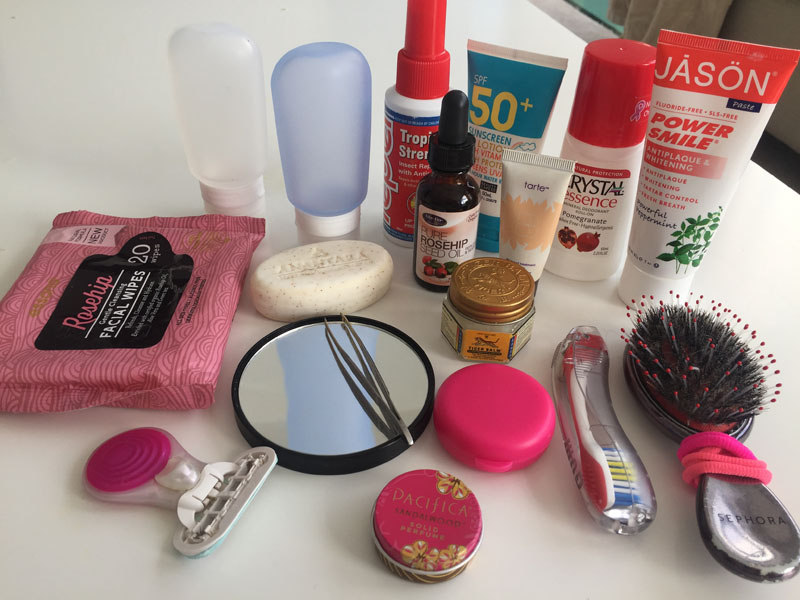
I’m also going to share a few tips for packing toiletries , how to lighten your load and share some of the best travel toiletries I’ve come across over my years of packing toiletries for flying, cruising, road tripping or backpacking. You’ll know exactly what toiletries to pack for a trip by the end of this post!
What You'll Find in This Post
The Complete Travel Toiletries List
Essential toiletries.
These are your travel toiletry essentials. Most of this stuff will feature on everyone’s toiletry bag checklist. If there are any things on this list of toiletries items that you don’t use at home then they’re probably not essential travel toiletries for you. A few of these items are personal preference only like hand cream or cotton buds. For guys, this is basically you whole toiletries list for men.
- Shampoo – Packed in GoToob Travel Bottles if you’re traveling less than 2 weeks or traveling carry on only.
- Conditioner – Packed as above
- Hair brush / comb
- Soap / body wash
- Toothpaste – Get a travel sized toothpaste if you’re traveling with carry on only
- Toothbrush – Folding toothbrushes like this are great for travel
- Dental floss – Pick a small travel size one
- Deodorant – Make sure it’s under 3oz if you’re traveling carry on only
- Facial wipes / cleanser – Wipes are easy and less messy than a liquid cleanser
- Facial moisturiser – I use Rosehip oil as it’s small, easy to pack and lasts a long time but whatever you use at home is right for you
- Body moisturiser – You can leave this out if you’re staying in hotels but bring it if you’re using Airbnb, cruising or prefer a specific brand
- Hand cream – Great for the flight!
- Lip balm – Great for the flight, sun or skiing
- Coconut oil – One of my top essential toiletries for traveling! Packing in a GoToob , it is so useful for travel as a moisturiser, after sun, shaving gel, hair treatment, make up remover etc. If you plan on using this, you can omit other items on this list as necessary.
- Razor – I use this small women’s travel razor
- Shaving gel / oil – Shaving oil is more space efficient and is a an essential for a men’s toiletries list
- Small mirror – I use this small magnifying mirror which has suction cups so you can use it on a hotel room window or mirror
- Nail clippers
- Cotton buds / cotton pads
Nice to Have / Trip Specific Toiletries for Vacation
These items are either things that are just nice to have or depend on the type of trip you’re taking. Here are some of the extra toiletries to take on vacation:
- Sunscreen – This sunscreen smells amazing!
- Insect repellent spray
- After sun lotion / aloe vera – For sunburn or moisturising your skin after sun exposure, toiletry bag essentials if you’re at the beach!
- Anti-chafe balm / powder – Get this anti-chafe balm if you’re traveling somewhere humid, doing a lot of activity or walking a lot.
- Foot powder – Pick up a travel size foot powder if you’re doing lots of hiking or walking around cities, you can also use anti-chafe balm for this.
- Tiger balm / Deep heat – If you’re on an active vacation like a ski trip this is great to have.
- Hand santizer
- Menstrual cup / Tampons / Sanitary pads – An essential part of any female toiletries list depending on what time of the month you’re traveling!
- Personal lubricant
- After shave / beard oil
- Contact lenses and solution
- Essential oils – If you need them, pack them in these small travel bottles for essential oils
Hair & Beauty Toiletries for Women
A lot of these are women’s toiletries. Mens travel toiletries are a little more simple so guys can skip this section almost entirely. Most of these are toiletries to pack for vacation, when you’re going on a cruise, to a nice resort or on a weekend city break. If you’re backpacking toiletries like this probably aren’t necessary.
- Hair ties – Wrap your hair ties around the handle of your hairbrush and then slot your bobby pins in over the top!
- Travel Flat iron – If you have hard to control hair, consider bringing a flat iron. Here’s my list of the best travel flat irons.
- Travel hair dryer – Most hotels have a hair dryer in the room but bring your own if you’re staying in an Airbnb or at a friend’s house. Here’s my list of the best travel hair dryers on the market.
- Dry shampoo – Get a travel size dry shampoo spray
- Hair styling products – Travel size versions of hairspray and styling gel are easy to find or put your gel into a GoTubb
- Shower cap – If you’re staying in a hotel, it’s not necessary but if you’re in an Airbnb or staying at a friend’s then it’s useful
- Make up brushes
- Make up remover
- Eye cream – You can scoop some into a little pot like this for travel
- Solid perfume – These are great for travel! The Pacifica brand has some lovely Hawaiian scents in their range.
First Aid Kit
A small first aid kit is a very useful addition to your travel toiletries list. I pack mine into a Ziploc sandwich bag and just tuck it away until I need any of the items. You don’t need to bring the whole box of Bandaids or rehydration sachets, just a few of each item is enough.
- Bite / sting cream
- Immodium – Anti-diaharreal tablets for any emergency situations!
- Pain relief – Ibuprofen, panadol or asprin
- Antacids – These are so useful if you’re going somewhere that has spicy food!
- Rehydration salts – In case of any Delhi belly, important for kids.
- Vitamin C sachets
- Throat lozenges
- Digital thermometer – This should definitely be on your toiletries travel bag list for any families traveling with small kids.
The 10 Best Travel Toiletries Items
Add these to your toiletries shopping list! After many years, I’ve worked out these are some of the best toiletries for travel . Pack your favorite items, of course, but give these items a try when putting together your toiletry kit list.
Folding toothbrush
One of my latest travel toiletries essentials is a folding toothbrush. Not only do they take up less space and fit into a Ziploc bag but they also protect your toothbrush bristles from germy surfaces or cross-contamination.
One of my favorite travel kit toiletries for packing light! These squeezey silicone tubes are perfect for shampoo, conditioner, coconut oil, body wash or any liquid you want to turn into travel mini toiletries. It’s easy to squeeze the liquid out and they don’t leak at all. They come in 2oz or 3oz sizes so are ideal for traveling carry on only.
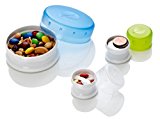
The tub version of GoToobs, a GoTubb lets you put an thicker creams or gels into smaller containers for travel. Very useful for things like eye cream or hair gel. You can also use them for pills, vitamins or even snacks.
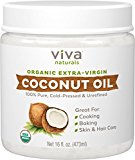
Coconut oil
One of the most useful toiletries to take travelling! You can use coconut for so many different purposes. It’s one of the toiletries travel bloggers most often recommend. It does just about anything! I use mine in lieu of eye make-up remover, body moisturiser, shaving gel, massage oil, hair oil and after sun cream.
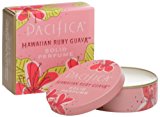
Solid perfume
I love having a little pot of solid perfume to travel with because it’s such a nice pick me up when you’re feeling travel tired, smelly or just want to juzz yourself up for a night out. This Pacifica one comes in lots of great travel themed scents also!

Ziploc bags
Ziploc bags are so useful for packing toiletries for plane trips as they make it easy to pull your liquids out for security checks. If I’m traveling carry on only then my toiletries for air travel go into a Ziploc bag. You can also use Ziploc bags to tip vitamins into and leave your bulky bottles at home. Just write the contents and dosage on the outside of the bag.

Magnifying mirror
A small magnifying mirror like this one is so useful for travel because it has suction cups so you can stick it to a hotel window or mirror when you’re doing your eye make up or using your tweezers.
Small brush
A decent travel size hair brush saves a lot of space in your travel toiletry bag.
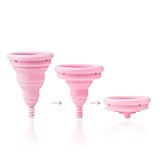
Menstrual cup
For all the ladies, if you haven’t tried out a menstrual cup then you should definitely give it a go as it’s so useful for travel. A menstrual cup is a reusable tampon alternative that gives you 12 hours of protection and can simply be rinsed and reused. This collapsible one saves a lot of space and comes in a neat little travel container.
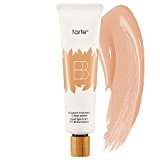
Another one for the ladies, BB cream is for your travel make up kit! It gives light coverage which is great for wearing make up in hot climates and also contains a sunscreen. I love this Tarte BB cream because it is very light and dries to almost a soft powder. Plus it comes in a 1oz travel size so is perfect for traveling light.
Tips for Packing Toiletries
Using my travel tips packing toiletries is easy! Here are a few of my best tips for traveling with toiletries and avoiding spillage or overpacking.
- Packing toiletries for flight – I always pack my flight toiletries in Ziploc bags in case of spillage as the air pressure of the plane can cause bottles to squeeze in and push the contents out, even if the lid is screwed shut! To avoid messy situations pack anything that might leak into a Ziploc bag and then put it inside your toiletry bag. You’ll notice that my toiletries list for air travel includes packing shampoo and conditioner into GoToobs. This is because these won’t leak. Still, be careful with any liquids.
- Packing toiletries for international travel – Unless you’re going somewhere very remote or off the beaten path, you will be able to buy most essential toiletries for travel when you’re abroad. You might not be able to get certain brands you love so if you’re picky, bring them with you.
- Packing toiletries for carry on luggage – When packing toiletries for air travel you need to adhere to the guidelines of items under 3oz or 100ml. It’s easy to purchase travel-size versions of most ladies toiletries and mens toiletries. Or you can decant your larger shampoo/conditioner bottles into GoToobs. Another alternative is to use a solid shampoo bar although I personally don’t like these and many of them require you to rinse your hair with vinegar afterwards anyway.
- Pick the right toiletry bag – When picking a toiletry bag, look for one that has good waterproof/spill-proof fabric in case of any leakages. A hook for hanging is also really useful so you can hang up your toiletries when there isn’t a lot of counter space. I really like this eBags flat toiletry kit because all the items lay flat in one layer so it’s very easy to find what you’re looking for in your bag. Here’s my full review of the eBags Pack It Flat Toiletry Kit.
Printable Travel Toiletries Checklist
You download my complete toiletry items list here and print it out to pack for your trip. Now you can get organised and get all your toiletries to bring on vacation together. packing list toiletries
>>>>>Click here to download the printable PDF toiletries list for vacation here <<<<<
Any questions or comments on what toiletries to pack for vacation?
I hope you’ve found my list of toiletries for travel useful. As it’s written from my perspective it’s obviously more a women’s toiletries packing list, but guys can definitely adapt it to a list of travel toiletries for men by cutting off the hair and beauty items and all the fancy creams. For families, these travel essentials toiletries are all the same so you’ll just need to add in your kids’ toothbrushes and make sure you have child suitable pain relief and a digital thermometer.
Here’s a quick summary: When you travel pack toiletries that you use at home, go for mini versions or put them in GoToobs, bring any trip specific items as needed and then use the best way to pack toiletries for air travel by putting them in Ziploc bags or a great toiletry kit bag.
What’s on your toiletry bag list? Do you have any trips on what toiletries to take on holiday? I’d love to hear from you if you have any great products or ways of packing them.
Pin this post for later!
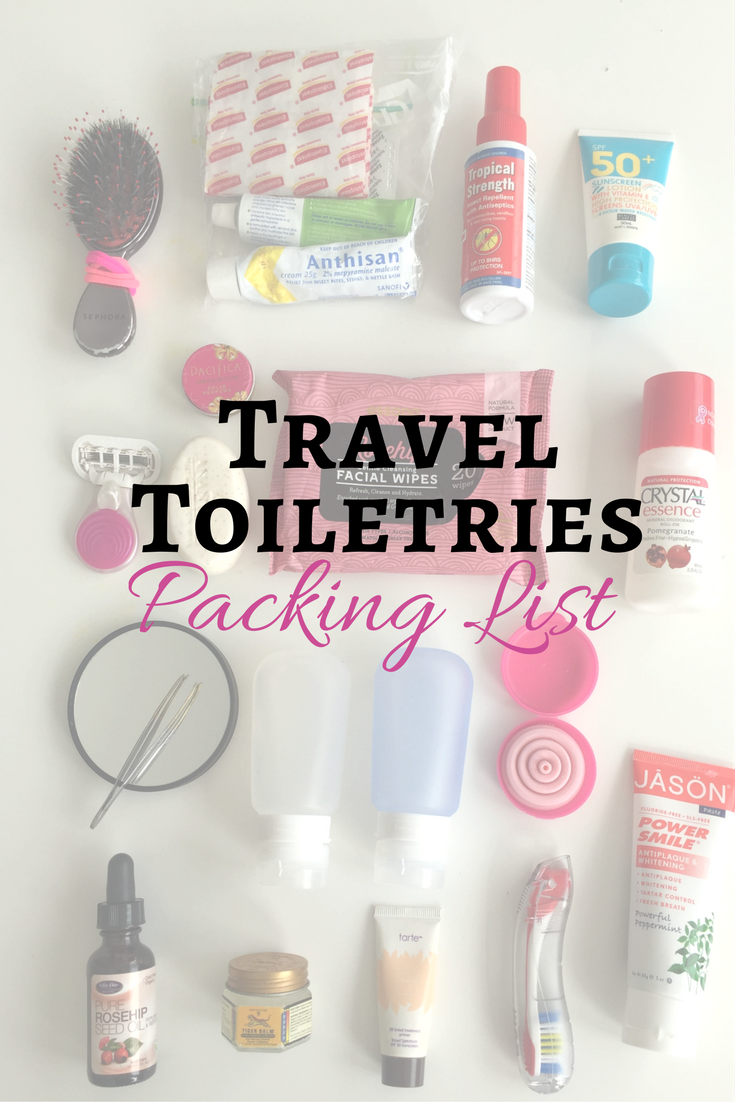
- Pinterest 3.3k
- Send to a Friend 10

Leave a Comment Cancel reply
Save my name, email, and website in this browser for the next time I comment.
This site uses Akismet to reduce spam. Learn how your comment data is processed .
Flashpacker Family is a participant in the Amazon Services LLC Associates Program, an affiliate advertising program designed to provide a means for sites to earn advertising fees by advertising and linking to amazon.com and its partners.
Affiliate advertising is used throughout this site. These affiliate ads allow me to earn a small commission on any bookings you may make but they do not incur any extra cost to you.
You can read our privacy policy here.

Start typing and press Enter to search

Travel medical kit checklist
by myDr | Ear Nose and Throat Health , Health Insurance , Travel Health

Use this checklist as a guide to things you may need in your medical kit when travelling – you may need less or more, depending on the activities you may undertake, and the remoteness of the area you visit.
Think about the area you are visiting and what may or may not be available there. Some careful planning and packing before your trip can avoid any wasted time, inconvenience or worse while you’re away. Check with your doctor or travel clinic for advice if you aren’t sure what you may need to keep your travels safe and healthy.
- Analgesic (pain relief) medicine such as paracetamol or aspirin.
- Antihistamine tablets for bites, stings or allergies.
- Cold and flu tablets.
- Cough medicine.
- Motion sickness tablets.
- Throat lozenges or drops.
- Antiseptic solution for cleaning wounds or bites.
- Antiseptic ointment to apply to a wound.
- Blister and wound patches, such as sticking plasters.
- Medical adhesive tape, e.g. Micropore.
- Wound dressings , e.g. a crepe bandage, gauze swabs and OpSite, and Steristrips, which can often take the place of stitches.
- Safety pins, scissors and tweezers (you may not be allowed to carry these in your cabin luggage).
- Insect repellent containing DEET (diethyl toluamide).
- Sting relief solution, e.g. Stingose (aluminium sulfate).
- Diarrhoea medicine, e.g. Imodium (loperamide).
- Mild laxative, for constipation.
- Antacid for indigestion.
- Antifungal or antibacterial cream.
- Low potency hydrocortisone cream.
- Fluid and electrolyte replacement powder or tablets, e.g. Gastrolyte or HYDRAlyte.
- Eye lubricant drops.
- Sunscreen (at least SPF 30+).
- Thermometer (a forehead thermometer is best for travel as it doesn’t break or run out of batteries).
- Health insurance card.
Other items you should think about taking, depending on your individual needs and your destination, include:
- Regular prescription medicines, which should be kept in their original containers with clear labels and carried in your hand luggage when travelling. You should also take a letter from your doctor stating the names of the medicines, the dose and that they are for your personal use, plus a copy of your prescriptions, written using the generic name of the drug to avoid confusion with trade names in foreign countries. Some countries may not let visitors bring in certain medicines, so you may wish to check first with the embassy or consulate in Australia, before you go. The Therapeutic Goods Administration (TGA) in Australia has information on travelling with medicines.
- Medical equipment you use regularly, such as sterile syringes and needles.
- Spare pair of glasses or your eye prescription.
- Condoms, birth control pills, or other contraceptives.
- Water purifying tablets.
- A mosquito-proof bed net.
- Hand sanitiser or wipes.
- Digital thermometer.
- Sterile syringes.
- First aid reference.
Prescription medicines for travel-related conditions
Travel to developing countries, remote areas, tropical climates and high altitudes increases your risk of certain conditions that you would not encounter at home or during travel to developed temperate-climate countries. Many of these conditions are treated or avoided by taking prescription medicines. So, apart from taking your regular prescription medicines with you, as described above, your doctor or travel clinic may suggest some of the following:
- Altitude sickness medicines.
- Antibiotics for certain intestinal infections or for serious respiratory infection.
- Malaria prevention tablets.
Popular Reads

31 Cruise First Aid Kit Essentials You Need to Have
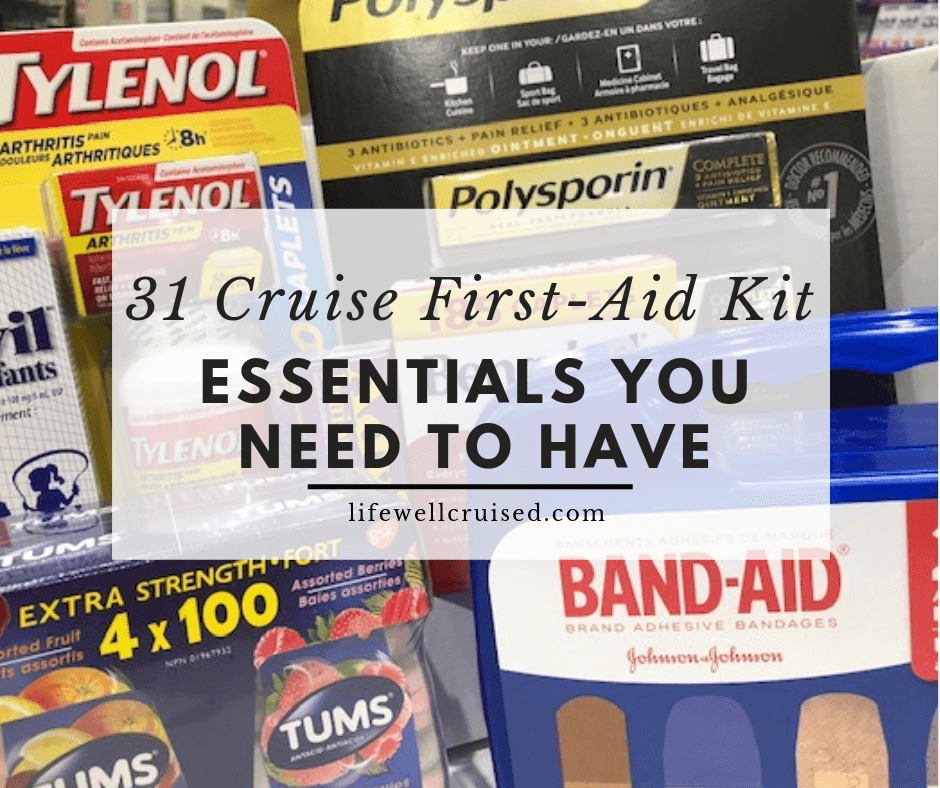
Sharing is caring!
As you are getting ready for your cruise and working on your packing list, don’t to forget about your cruise first aid kit essentials.
As travelers and cruisers, we hope not to have to use them. However, being prepared with your travel first aid kit , is one of the most important cruise preparations you can make.
I like to keep my cruise first aid kit together, and ready for use every time we cruise. Before each cruise, I simply take inventory and replenish as necessary.
Now, if you did forget something, you can pick up a few small items in the cruise ship’s convenience store.
That said, I will guarantee you that it will be more expensive and the variety of items is extremely limited. Worse than that, if something occurs when the shop is closed (as they close while in port as well as at night), you could be really stuck.
To Note: On a cruise ship, there is a ship’s doctor and medical staff. So while this post is about being prepared for minor situations where first-aid treatment or pharmaceutical products might be necessary, please do not hesitate to visit the medical centre should you need medical treatment or advice.
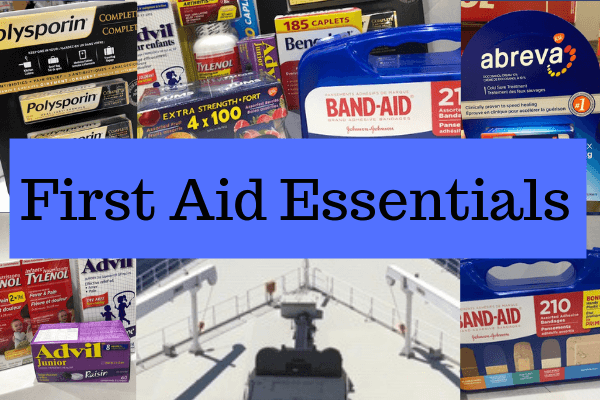
This post contains affiliate links which means if you click and buy that I may make a commission, at no cost to you. Please see my disclosure policy for details.
As an Amazon Associate I earn from qualifying purchases.
First Aid Essentials for a Cruise
Small wound treatments.
It’s so common while on a cruise, or on any travels, to get small cuts, scrapes, blisters etc. Those little non-emergency things can happen so bring along a few things to make sure a little issue doesn’t become a bigger issue.
1. Band-aids
I always need a few bandages for blisters . New shoes, or walking so much more than usual just seem to bring this on. I bring some that are made for blisters, that will stay on in that water.

Recommended: Blister bandages of different sizes (see details & over 4000 reviews on Amazon here)
2. Antibiotic Ointment
Antibiotic ointment is great to have with you on excursions or in your cruise cabin. It heels small cuts so quickly and is said to prevent infections and is a must-have when you travel.

Recommended: Travel size antibiotic ointment
3. Hydrocortisone Cream
Recommended: Hydrocortisone cream (check price & read more than 30000 Amazon reviews here)
4. Gauze and Alcohol Wipes
Some small gauze and alcohol wipes can be useful for scrapes or anytime you need to disinfect, especially if you’re on a shore excursion or off the ship.

5. First Aid Kit
A first aid kit that you bring with you on your cruise is such a good idea! Plus, you can use it later in the house or even for road trips – plus future cruises of course!

Recommended: Emergency first aid kit (see price & 60,000+ Amazon reviews here)
Medications and Pharmaceutical Products
6. pain relief medication.
Bring along some of your preferred pain medications such as Advil and Tylenol or a brand you like and trust.
7. Cold Medicine/Sinus Medication
8. Cough and Sore Throat Medication
Cough candies and throat lozenges are a must, with dry sea air, bring some along in different flavors.

Recommended: Cough and sore throat drops
Tip: Make your own mini DIY travel first aid kits in small ziplock bags. These are perfect for the plane, for cruises and road trips.
9. Prescription Medication
It may go without saying, but do make sure your regular (or less regular) prescription medications make it onto your cruise packing list . There may be medications you don’t use daily, but they are important to have with you just in case. So, do make sure these are packed.
Tip: Cruise lines recommend that you bring at least 14 days of extra medication, as an extra precaution.

10. Coldsore/Fever Blister Medication
11. Eye Drops
Recommended: Eye drops (see reviews and check price on Amazon here)
12. Ear drops
First Aid Tools
13. tweezers.
Tweezers don’t seem necessary until you or your child gets a splinter. Just throw it in there and forget about it.
14. Thermometer
A thermometer should be part of your first aid kit, but if you have kids, having one on hand is a necessity.
15. Travel Flashlight

I like to bring a small flashlight when we travel. I just make sure the battery is still working, and if not I replace or buy a new one.
This is really my own thing and I know not everyone is a worrier like me. When I get to a hotel I always check where the exits are so you get where I’m coming from – I’m safety conscious.
However, I think there’s a good case to be made for why a flashlight could be very important in an emergency situation, so it lives in my cosmetic bag and travels with us.
Recommended: Small bright flashlight (check price & see 20,000+ excellent Amazon reviews)
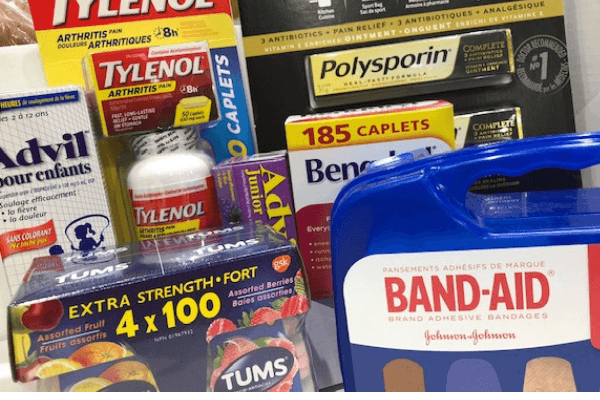
Stomach and Digestive Issues
16. antacids .
Tums, Rolaids or Pepto Bismol can be useful for nausea, heartburn, indigestion, upset Stomach, and diarrhea. Whether it’s due to eating or drinking too much, or just having a bit of traveler’s stomach, it can be so useful. We’ve even found if a touch of ship movement is bothering us, a chewable antacid has brought such relief.
I also bring a few of these along in a little portable ziplock first-aid baggie I make up for excursion days.
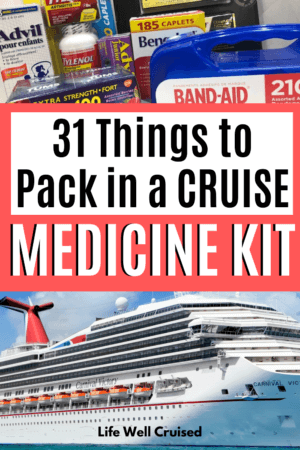
17. Imodium (diarrhea medication)
You can get an upset stomach for a variety of reasons. Now if it’s a flu and you need to see the ship’s doctor, definitely do so. However, if you get a bit of traveler’s stomach bring along some Imodium.
18. Re-hydrating tablets
If you’ve felt ill or gotten to much sun, re-hydrating tablets can help to make you feel like yourself again. Basically this replenishes your electrolytes (it’s amazing what we lose in energy when our electrolytes are off).
19. Laxatives
Sun safety and preventing sunburn on a cruise
20. sunscreen.
Having a high SPF, good quality sunscreen is a must, especially if you’re on a Caribbean cruise.
On our first cruise, we couldn’t believe it! Although we’re Canadian, we actually love the sun and had a pretty good base from many hours at our community pool that summer. My husband was a bit stubborn and didn’t want to wear the sunscreen that first day.
Needless to say, he suffered a bit the next couple of days and was slathering on the aloe vera!
That hot sun reflecting over the water is something else!
If you are cruising in the Caribbean or Bahamas, it’s a good idea to bring reef safe sunscreen .
Recommended: Reef-safe sunscreen (check Amazon reviews & info here)
Get The Ultimate Cruise Planner
Regular price: $27 now just $17.
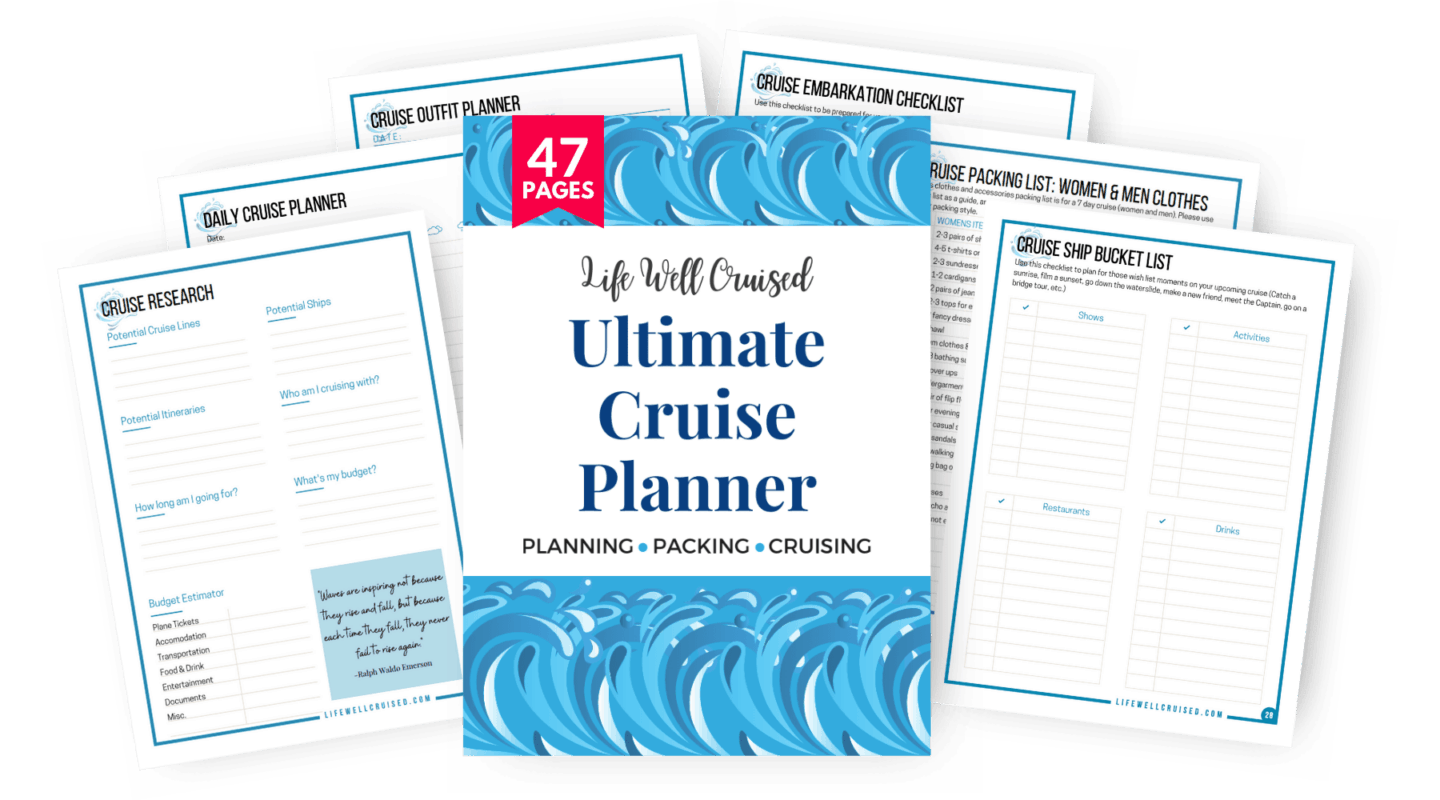
21. Aloe Vera Gel
Recommended: Aloe vera gel (organic & non-sticky)
22. Lip Balm
23. Mosquito Repellent
24. Calamine Lotion
25. After-bite
Recommended: After bite treatment (check reviews & price on Amazon here)
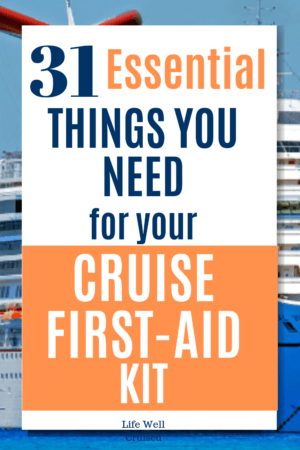
Allergic Reactions
26. benadryl.
Allergic reactions can happen and can be unpredictable. Obviously if you already know you or your child has an allergy, you probably have medication (perhaps a Epipen) and know what to do should this occur.
However, people can get unpredictable allergic reactions, or even sensitivities unpredictably. Whether from a food that’s new, or from a lotion or product, reactions such as swelling and hives can happen.
Seasickness Medications
There are many ways to deal with seasickness while on a cruise , and having some of these items with you is a good idea.
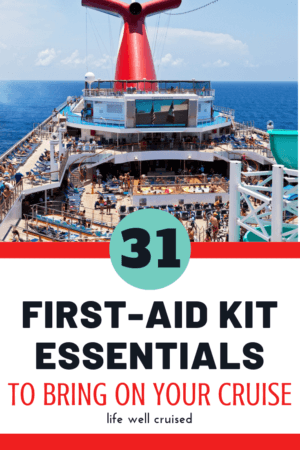
27. Motion Sickness Patches (behind the ear)
Placed behind the ear, motion sickness patches are a recommended treatment if you are prone to motion sickness. There are some pros and cons, so make sure to check any potential side effects.
Recommended: Motion sickness patch
28. Seabands
This is a favorite for many as they are natural, reusable, and so many people love them and have good results.
29. Seasickness Medications
I definitely recommend bringing some seasickness medications in your cruise first aid kit. I really don’t get seasick, but I’m always prepared just in case.
Either Dramanine or Bonine work well for many cruisers. My husband is more affected by the movement, and does very well with Bonine and does not experience drowsiness.

Recommended: Bonine motion sickness tablets
Recommended: Ginger chews (check price & Amazon reviews here)
Other Essentials to Stay Healthy on a Cruise
31. Hand Sanitizer
Bring a small hand sanitizer bottle everywhere, and especially when you leave the ship to go on an excursion or even to go shopping. You touch money and all sorts of things, and hand sanitizer is great until you get back to the ship and can wash your hands with soap and water.
Travel Tip: Create portable mini-first aid packs (with ziplock baggies)
Something I always keep with me on my cruise packing list , is ziplock baggies. I always have a little ziplock baggie filled with a few simple first aid products that stays in my tote or beach bag for excursions.
Although our larger cruise first aid kit is filled with various products and medications, it stays in our cruise cabin unless we need anything. The little mini first aid emergency kit just keeps a few basics such as waterproof bandaids, neosporin, alcohol wipes, tums or pepto bismol, pain reliever. You can personalize this to your needs.
We keep one packed in our shore excursion bag ready to go!
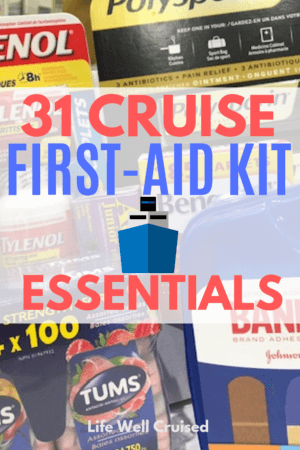
RECAP: 31 Essential Items for Your Cruise First Aid Kit
We’ve gone over the most important products to bring with you on your cruise in your cruise first aid kit. Keep in mind that the ship stores are quite small and products are limited. As well, the prices will likely be double or more than what you’d pay back home.
Take a look through the list and see which items will be most necessary for you and your loved ones on this cruise.
Other posts that might be helpful as you plan your cruise essentials:
17 Cruise Stateroom Essentials Every Cruiser Needs
50 Amazon Items to Bring on a Cruise
Have you started to pack your cruise emergency pack yet? Have you got any items in mind that I should include? Please let me know in the comments below.
Happy Cruising!
P.S. If you enjoyed this post and found it helpful, please don’t keep it to yourself ;-). Feel free to share on Pinterest, Facebook or Twitter (share buttons at the top). Thanks so much!
Let’s connect:
Follow me on Facebook at Life Well Cruised
Follow me on YouTube at Life Well Cruised (Vlogs and cruise tips)
Follow me on Pinterest at Life Well Cruised
Follow me on Instagram at Life Well Cruised
14 Comments
Great list! The cruise ships overcharge for these items – if they have them!
So glad this list was helpful. That’s very true. It’s the worst when you can’t even find what you need!
Thanks for taking the time to comment!
I always pack at least two flashlights in my 1st aid kit. You never know when a power outage my occur, don’t want to use up my cell battery running the flashlight.
Great idea!
Most cruise ships offer first aid services but why not make sure that you have everything you need at the palm of your hands, right? Personally, I also like having medications and most of the things I need in my luggage.
Absolutely – every cruise we’ve been on has first aid services, so there’s never an issue. I’m with you, I like to be prepared so I don’t have to go to the infirmary (and pay) for small issues.
Thanks for taking the time to leave a comment.
I’ve done a few cruises and traveled a lot and always take my own first aid stuff. This has actually made me realize I’m missing a few things and I love the idea of the small baggie for excursions. Thank you and I’m going to redo my first aid stuff right now. Cruise is in early September to Alaska.
Glad you found that little tip helpful. Have an amazing cruise!!
I love that you touched on getting some gauze and alcohol pads so that you can have access to those when you need to disinfect. My partner and I are thinking about going on some trips this year and we want to be sure we know how to provide first aid. I think it’s a good idea to take a class so that we get taught by professionals.
I think that’s a great point. I actually wish we all took a first aid course both in high school, and every few years as adults. I take one every few years as a requirement, and agree it’s extremely beneficial.
I hope you have a great time on your future travels!
When you’re confused on a cruise or during a foreign port on a shore excursion, care provides will be overpriced and generally laborious to search out. Although giant cruise ships do have a medical workplace with a doctor and several other nurses, you almost certainly won’t need to go to only for one thing basic sort of a band-aid or some Nuprin. I think it’s a great list. And quite helpful too.
Glad you found the list helpful Mark. I agree it’s better to have some basic first aid stuff, rather than to go to a medical center unless you need too.
I am a retired RN and there are some really freat ideas here which have me adding to my list! Thank-you.
I’m so glad this was helpful!
Leave a Reply Cancel reply
Your email address will not be published. Required fields are marked *
This site uses Akismet to reduce spam. Learn how your comment data is processed .

Every Road Trip Car Breakdown Kit Should Include These Tools, According To Our Travel Expert
T here's nothing like taking an epic road trip. It's undeniably a perfect way to travel , especially if you're exploring large countries like the United States. Unfortunately, traveling by car comes with all sorts of problems. Many of the best road trips take you to remote, off-the-beaten-path destinations where you can experience the natural beauty and rugged landscapes, but it also means you'll be far away from any mechanic should something go wrong with your car.
According to data gathered by Agero, more than 69 million cars break down in the United States each year, and an AAA report shows that if your car is over 10 years old, you run an even higher risk of car trouble. Nothing ruins an unforgettable road trip vacation like being stranded on the side of the highway for hours while you wait for a tow truck. Even the most seasoned road tripper can face problems if unprepared. With some preparation and planning, you can avoid getting stranded roadside by packing a car breakdown kit.
Nate Murphy, author of the best-selling Van Conversion Guide and founder of DIYhero, a van conversion course , has spent years of his life on extended road trips. In an exclusive interview with Explore, Nate told us everything he recommends, including packing a road trip breakdown kit to get back on the road faster when you run into unfortunate car trouble.
Read more: Safety Items You Should Pack For Your Next Road Trip
Perform Some Basic Vehicle Checks Before You Begin Building Your Tool Kit
Before you begin building your road trip breakdown kit, having your car checked out is a good idea. Going to the mechanic for a trip check is much like going to the doctor for a check-up but on your vehicle. You don't want to wait until something goes wrong to have things checked out. Nate Murphy suggests taking your car to a trusted mechanic before your trip to ensure nothing major is wrong and to help you feel safer on a long-haul road trip. "If your vehicle is due for a service or has been showing signs of trouble, it's a good idea to address these issues before hitting the road. No one wants to spend half their road trip waiting for a vehicle to get fixed," Nate told Explore.
Even if your car seems okay, Nate recommends doing some basic checks. "This includes checking the oil, coolant, brake fluid, transmission fluid, and windshield washer fluid levels. Additionally, check the condition of the brakes, tires, and lights" he told us. Before you begin purchasing items for your kit, read over your owner's manual because tools can depend on the make, model, and year of your car.
Plan Your Route Ahead Of Time So That You Can Be Prepared For All Types Of Conditions
Nate Murphy has ventured all over on road trips, so he knows what to expect in almost any situation. If you're new to road-tripping or visiting an area for the first time, he suggests doing some research ahead of time so you know what to expect. "Properly consider the weather and road conditions you may face on your trip. If you are traveling through mountainous terrain, or other places where it may snow, be sure to pack snow chains or socks — or appropriate tires," Nate told Explore.
You should also check that you know how to use everything you bring for your vehicle. Ensure you know how to apply the chains before you leave because "no one wants to be figuring that out in the freezing cold!" he reminded us. Knowing the weather, terrain, and potentially hazardous conditions along your road trip route will ensure you pack everything you need and can make road trips so much easier.
Take Care Of Your Tires
Once you're well aware of the condition of your vehicle and the conditions on your road trip route, it's time to start packing the perfect road trip breakdown kit. During his many adventures, Nate discovered that self-sufficiency is vital when traveling. He recommends packing some essential tools to be well-prepared and ensure your trip is stress-free. First, he suggests purchasing a tire foam or tire repair kit to help repair them quickly. "If far away from services, this cheap and lightweight item can be a lifesaver. It is worth checking out how to use them before you go, just in case you do not have data," he told us.
In addition to the tire repair kit, ensure you have a tire pump for when you have a slow leak and need to add air to balance your tire pressure. Some varieties run off your car's battery, and manual pumps are also on the market. Most cars have a spare tire in the back, so pack a four-way lug wrench if you need to change one during your trip. "I would recommend that you learn how to access the spare tire before you go, on some vehicles this is a little more complicated than you may realize," Nate told us.
Prepare For Battery Problems
Chances are, there's probably been a time in your life when you've returned to your vehicle only to find that the engine won't start. Perhaps you were so excited to hit the trails that you unknowingly left your headlights on or something plugged into the vehicle that slowly drained your battery. We've all been there!
According to Nate, "A dead battery, especially in colder weather, is not uncommon." He's right — it's one of the most common car problems. And since batteries are one of the most critical aspects of our car's electrical systems, the vehicle will not turn on without a jump start. Keeping jumper cables in your car is always a good idea, especially on a road trip. Nate recommends keeping cables at least 16 feet in our road trip breakdown kit so that a kind passerby can jump you in a pinch. It will also ensure you're empowered to help other, less prepared road trippers should you run into someone who needs a battery jump during your travels.
"Again, spend 20 minutes to familiarize yourself with how to properly jumpstart an engine," Nate told us. If you're traveling to a super remote area, consider a 12-volt battery-operated jump starter that allows you to give your car battery the boost it needs without the help of another vehicle. Prices for the portable jump starters start at about $50.
Other Essential Items To Keep In Your Road Trip Car Breakdown Kit
Nate recommends packing a socket wrench set before you head out. Socket wrenches are handy for all repairs, especially if you're familiar with a car engine. "If you know nothing about engines, this might not be so useful — but if you have a bit of an idea, you can fix something before you get to a mechanic," he told Explore.
Bring a flashlight for car problems at night so you can see what you're working on. A reflective triangle is also helpful for safety during late-night road trips . Duct tape can be beneficial for temporary fixes, and a multi-tool is suitable for all sorts of repairs. Pack a physical map in case your phone unexpectedly dies, or you don't have enough signal to use GPS.
"Lastly, check that you have appropriate breakdown assistance and insurance," Nate told Explore. "A roadside assistance plan can save you thousands if you break down somewhere remote or need a tow." You should call your insurance before you depart and ensure you're covered for your trip, especially if traveling internationally. Adjusting your policy to ensure that you're covered is a good idea. Once you've created your perfect car breakdown kit, it's important that you periodically check that everything is in working order. Some items, like tire repair kits, may expire, so ensure your equipment is up to date before each road trip.
Read the original article on Explore .
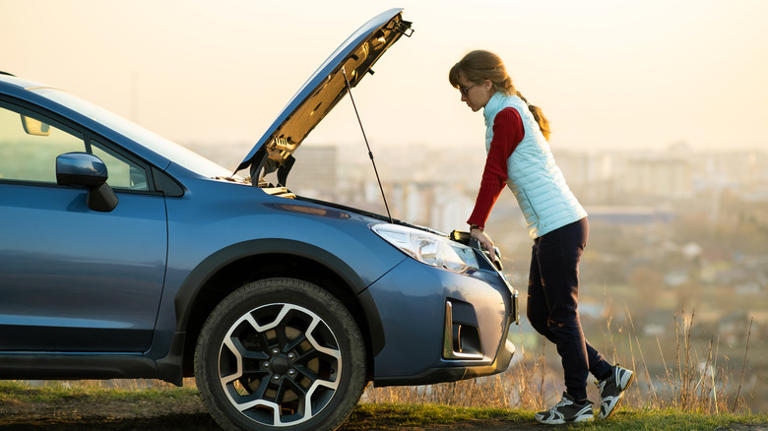
Protect Your Trip »
The 10 best toiletry bags of 2024, according to travel experts.
Tote everything from toothpaste to aftershave in one of these bags.
The Best Travel Toiletry Bags

Getty Images
Of all the travel accessories you can own, a toiletry bag may be the most essential – especially if you want to avoid leaks and spills in your luggage. Toiletry bags are necessary for keeping shampoo, toothpaste and other personal care items contained and organized when traveling.
Based on our personal experiences as well as consumer reviews, we've chosen the best toiletry bags in a number of categories, from the top option for men to the best hanging toiletry bag (especially useful in tight spaces like cruise ship cabins).
Best Overall: Peak Design Small Wash Pouch
- Jump to features and expert insights ↓
Best Dopp Kit: Cotopaxi Nido Accessory Bag – Cada Día
Best for men: topo designs dopp kit, best for women: lug trolley mini cosmetic case, best kids: wildkin toiletry bag, best large: l.l. bean personal organizer toiletry bag, large, best small: away the small toiletry bag, best hanging: open story small hanging toiletry bag, best clear: fawn the toiletry case large.
- Best Leather: Mark & Graham Dual Travel Organizer – Large
(Note: Prices and availability were accurate at the time of publication; they may fluctuate due to demand and other factors. All toiletry bag dimensions are listed in order of length by width by height.)

Courtesy of Peak Design
Dimensions: 6 x 10.2 x 4.4 inches
This toiletry bag earns rave reviews for its compact design and variety of internal compartments, which include four mesh pockets, a zip pocket and a magnetic pocket designed for your toothbrush. The bag is also versatile – its structured build means it won't flop over when you set it on the bathroom counter, while an attached hook allows you to use it as a hanging toiletry bag as well. Available in black and sage (as well as a larger size ), the Peak Design Small Wash Pouch is weatherproof and easy to clean.
What our editors say:
This toiletry bag perfectly fits all of my travel-sized essentials for a trip and I love the separated compartment pockets. It's pretty small and its soft exterior makes it easy to shove into a carry-on or a personal item without taking up too much room. It also sits upright on its own, which is a nice touch. – Erin Evans , Managing Editor
Price: $49.95 or less

Courtesy of Cotopaxi
Dimensions: 6 x 9 x 5 inches
If you're looking for a Dopp kit (a style of toiletry bag, typically with a side handle), the Nido Accessory Bag – Cada Día is a solid choice. The toiletry bag offers three compartments as well as an interior zippered pocket. Plus, it's available in Cotopaxi's vibrant color combinations.
The Nido Accessory Bag can fit a lot – much more than I expected, in fact. I can pack my electric toothbrush (with its case!), a full-sized toothpaste, a hairbrush, makeup and more. Even with how much it can fit, I don't find that the bag takes up a lot of space in my carry-on. I especially love the Nido's three different compartments (plus a zippered pocket) to organize my toiletries and accessories. – Leilani Osmundson , Senior Digital Producer
Price: $45 or less

Courtesy of Topo Designs
Dimensions: 5.5 x 11 x 5.5 inches
Not only does the triangular shape of this toiletry bag make it unique, but it also allows the bag to stand upright on its own. The Topo Designs Dopp Kit is bigger than it looks, and its main compartment offers plenty of space for all the necessities including a razor. The bag is available in a variety of bright two-toned styles and solid colors.
The Topo Designs Dopp Kit's bright colors and unique triangular shape inspired my initial purchase, but its versatility and durability quickly made it my go-to toiletry kit for every type of travel. The spacious bag works just as well in my carry-on as on a camping trip and has stood up to countless spilled shampoos and exploded toothpaste tubes. The Dopp kit stays upright on counters, while the attached hook makes it easy to hang and dry. – Zach Watson , Senior Editor
Price: $34 or less

Courtesy of Lug
Dimensions: 4 x 8.75 x 3.75 inches
Lug's Trolley Mini Cosmetic Case is perfect for both toiletries and makeup. Inside, the main compartment features a patterned lining and two zippered pockets: one on the back wall and another on the lid. On the outside, there are two side pockets plus a front pocket with a divider for even more organization.
I've had this toiletry bag for four years, and it is the first thing I pack for every trip! I absolutely adore its compact design, multiple zippered compartments that make it easy to reach your essentials without having to sort through an entire toiletry bag, and the wipeable interior (for when that foundation or shampoo leaks in transit). For longer trips, I have the Lug Trolley , which can even fit a curling iron. – Rachael Hood , Senior Editor
Price: $49 or less

Courtesy of Wildkin
Dimensions: 5 x 9.5 x 5 inches
Available in a wide variety of playful colors and patterns (think: trucks and mermaid scales ), the Wildkin Toiletry Bag is perfect for kids. The bag offers a spacious main compartment plus an internal zippered mesh pocket and an external zippered pocket.
I bought this bag to coordinate with my son's Wildkin Overnighter Duffel . The quality of both bags is top-notch, and I know we'll be able to use them for a long time. – Amanda Norcross, Senior Content & SEO Strategist
Price: $24.99 or less

Courtesy of L.L. Bean
Dimensions: 12.5 x 11.5 x 4 inches
The L.L. Bean Personal Toiletry Bag is a classic, and the largest size is perfect for weeklong trips and even multiple family members. In addition to having a variety of internal and external pockets, this hanging toiletry bag can hold up to 25 pounds. Available in a variety of colors, it also features a carry strap and tote handle as well as a small mirror.
While this kit comes in a few sizes, the large is my favorite. It fits everything I need for a trip, from shower essentials to makeup to medicine. The plastic front on the upper two compartments is beginning to wear away, but I can deal with that considering I've had mine for more than 10 years (if not longer). – Marisa Méndez , Senior Editor
Price: $44.95 or less

Tips on Trips and Expert Picks
Travel tips, vacation ideas and more to make your next vacation stellar.

Courtesy of Away
Dimensions: 5.5 x 8.3 x 3.15 inches
If you're looking for a small toiletry bag that can be used for short trips, this is the one. But don't let the small size (and name) of this toiletry bag fool you. Two interior zippered compartments – one clear, one mesh – are big enough to hold all of your travel-size toiletries plus medications for even longer trips, and the zippered exterior pocket is perfect for makeup wipes. When you inevitably get the bag wet, its water-resistant nylon material makes it easy to wipe dry. The Small Toiletry Bag is available in black, navy, blue gray and white.
This is the toiletry bag equivalent of Mary Poppins' bag. It holds way more than it looks like it can. – Amanda Norcross
Price: $55 or less
Dimensions: 8 x 8.31 x 3.5 inches
Not only is this hanging toiletry bag well organized, but it also costs less than $15 at Target. The toiletry bag has a built-in hanger, four mesh pockets (two of which have zippers) and an additional compartment that can hold travel-size (or even full-size) toiletries and makeup. It also has an external tote handle. The Open Story Small Hanging Toiletry bag is currently available in light blue.
I've used this toiletry bag for a couple years now, and it's great for my travel needs. The hanging hook saves me a lot of space, and there's plenty of organization inside – all for an incredibly affordable price. – Catriona Kendall , Editor
Price: $12.99 or less

Courtesy of Fawn
Dimensions: 6.5 x 9.5 x 3.5 inches
For a clear toiletry bag that makes it easy to see all of your essentials – plus a faux leather trim and matte gold zippers that make it just plain pretty – frequent travelers recommend this option by Fawn. Two interior compartments are large enough to hold both toiletries and makeup, and top grab handles make it easy to pull out of your luggage and transport wherever you go.
I was initially drawn to this bag for its clear vinyl compartments, but after using it for about a year I've been pleasantly surprised by how many items it can hold. I'm able to fit all my travel-size skin care and hair care products, and it doesn't take up too much space in my carry-on. It's also very easy to clean. – Ann Henson , Assistant Managing Editor
Price: $59.99 or less
Best Leather: Mark & Graham Dual Travel Organizer – Large

Courtesy of Mark & Graham
Dimensions: 6 x 9.5 x 2.25 inches
This toiletry bag is both elegant and efficient. Crafted with vegan leather, it's available in eight colors, including red, blush, camel, white and navy, all of which are accented by gold zippers. The toiletry bag has two spacious compartments and conveniently sits upright on flat surfaces.
I really like my large Dual Travel Organizer from Mark and Graham. The main compartment can hold your basic makeup essentials and a travel-sized toothbrush, and the bottom zippered section is ideal for jewelry, a contact lens case or hair ties. The vegan leather material is both soft and environmentally friendly, and you can also get the bag monogrammed for a personal touch. – Nicola Wood , Senior Editor
Price: $99 or less
Frequently Asked Questions
Per the Transportation Security Administration's liquids rule , a quart-sized bag is recommended for any toiletries packed in carry-on luggage ; however, a clear bag is not specified. What's most important is that any liquids (including creams, gels and aerosols) are placed in a small bag and do not exceed 3.4 ounces. For checked luggage , there are no limitations on toiletry bag and liquid sizes.
Anything you use for your personal hygiene at home should be packed in your toiletry bag. This can include:
- Conditioner
- Shaving cream
- Moisturizer
- Contact solution
- Contact lenses
- Feminine hygiene products
Depending on space, you may also want to pack the following items in your toiletry bag:
- Medications
Why Trust U.S. News Travel
Amanda Norcross regularly reviews and writes about travel gear. She consulted her team at U.S. News as well as recent consumer reviews to determine the best toiletry bags for men, women and kids.
You might also be interested in:
- The Best Packing Cubes
- The Most Useful Travel Accessories
- What to Pack in Your Carry-on Bag
- What Is Allowed in a Carry-on Bag?
Tags: Travel , Travel Gear
World's Best Places To Visit
- # 1 South Island, New Zealand
- # 4 Bora Bora
If you make a purchase from our site, we may earn a commission. This does not affect the quality or independence of our editorial content.
You May Also Like
The best charleston tours.
John Rodwan April 4, 2024

The Best Napa Valley Wine Tours
Amanda Norcross April 4, 2024

The 10 Best Denver Tours
Lyn Mettler April 4, 2024

Top Memorial Day Weekend Getaways
Nicola Wood April 3, 2024

The Best Way to Renew a Passport
Amanda Norcross April 3, 2024

The Best Checked Luggage
Erin Evans , Rachael Hood , Catriona Kendall , Sharael Kolberg , Amanda Norcross and Leilani Osmundson April 3, 2024

The Best Venice Tours
Lyn Mettler and Marisa Méndez April 2, 2024

U.S. News Best Bed & Breakfasts Rankings
U.S. News Hotels Editors April 2, 2024

The Best Carry-on Backpacks
Rachael Hood , Erin Evans , Catriona Kendall , Amanda Norcross and Leilani Osmundson March 29, 2024

Best Chicago Boat Tours
Holly Johnson and Marisa Méndez March 29, 2024


...HEAVY SNOW AND STRONG WINDS EXPECTED LATER TODAY INTO WEDNESDAY... WIZ013-020>022-031-037>040-045-048>050-073-074-021645- /O.UPG.KGRB.WS.A.0005.240402T1800Z-240403T1800Z/ /O.NEW.KGRB.WS.W.0004.240402T1800Z-240403T1800Z/ Northern Marinette County-Menominee-Northern Oconto County-Door- Shawano-Waupaca-Outagamie-Brown-Kewaunee-Waushara-Winnebago- Calumet-Manitowoc-Southern Marinette County-Southern Oconto County- Including the cities of Brillion, Sturgeon Bay, Oconto, Menasha, Keshena, New London, Manitowoc, Mountain, Oshkosh, Neopit, New Holstein, Kewaunee, Lakewood, Green Bay, Luxemburg, Fish Creek, Niagara, Waupaca, Sister Bay, Appleton, High Falls Reservoir, Wausaukee, Harmony, Crivitz, Loomis, Brookside, Peshtigo, Shawano, Little Suamico, Neenah, Two Rivers, Sobieski, Redgranite, Chilton, Pensaukee, Porterfield, Clintonville, Wautoma, Townsend, and Middle Inlet 341 AM CDT Tue Apr 2 2024 ...WINTER STORM WARNING IN EFFECT FROM 1 PM THIS AFTERNOON TO 1 PM CDT WEDNESDAY... * WHAT...Heavy snow expected. Total snow accumulations between 8 and 12 inches, with higher amounts to 14 inches possible in far northeast Wisconsin. Lesser accumulations possible near the lakeshore in Kewaunee and Manitowoc counties. Winds gusting as high as 45 mph, causing areas of blowing and drifting snow tonight into Wednesday. * WHERE...Portions of central, east central, and northeast Wisconsin. * WHEN...From 1 PM this afternoon to 1 PM CDT Wednesday. * IMPACTS...The strong winds and weight of snow on tree limbs may down power lines and could cause sporadic power outages. Travel could be very difficult. The hazardous conditions will impact the Tuesday evening and Wednesday morning commutes. * ADDITIONAL DETAILS...The heaviest snow is expected to occur this evening, when snowfall rates of an inch an hour or greater will impact much of east central and far northeast Wisconsin. PRECAUTIONARY/PREPAREDNESS ACTIONS... People should consider delaying all travel. If travel is absolutely necessary, drive with extreme caution. Consider taking a winter storm kit along with you, including such items as tire chains, booster cables, flashlight, shovel, blankets and extra clothing. Also take water, a first aid kit, and anything else that would help you survive in case you become stranded. &&
University of Michigan Athletics

Michigan to Travel to Bucknell for Four CWPA Matchups
4/3/2024 4:40:00 PM | Water Polo
By: Alex Whisnant
ANN ARBOR, Mich. -- The No. 11-ranked University of Michigan water polo team (17-8, 4-1 CWPA) will travel east to Lewisburg, Pa., take on four conference opponents, starting with a matchup against host Bucknell on Friday (April 5) at 4:30 p.m. Michigan will play two on Saturday (April 6), first taking on Princeton at 11 a.m. followed by Harvard at 6 p.m., and will close out the weekend on Sunday (April 7) at 9 a.m. against Brown.
• Michigan boasts a CWPA record of 4-1 heading into the weekend, with the lone loss coming against then-No. 10 Princeton on March 2. In its four wins, the Maize and Blue has averaged 12.75 goals.
• Emma Gustafsson was prolific on the offensive end of the pool during the Michigan Invitational on March 23-24 to earn CWPA Player of the Week honors on March 27. The freshman scored seven goals and dished out six assists for a team-high 13 points. Over half of Gustafsson's shot attempts found the back of the net.
• Kata Utassy leads the way for the Wolverines at attack. The senior has scored 53 goals and chipped in 30 assists for a squad-best 83 points. Utassy also has shined on defense, totaling 22 steals and six blocked shots in 25 games.
• Alison Lock has emerged as a solid offensive option for the Wolverines with 23 goals and 21 helpers this season. Her total of 44 points ranks third on the team. Defensively, Lock has seven steals, three blocks and 11 drawn ejections.
• Sammi Monroe sits third on the roster with 23 assists while her 19 scores are good for fourth. Lola Ciruli leads the team in steals with 27 and boasts 41 points (22 goals, 19 assists).
• In goal, Alex Brown has been stout, racking up 223 saves in 23 games and allowing 8.44 goals per game. For her career, Brown has 868 saves and is poised to become the fourth goalie in program history to tally 900 career saves.
• Michigan will look to repeat its performance from its previous trip to Lewisburg in 2023 when it went 3-0 at the Bucknell Invitational with wins over Bucknell, LIU and Saint Francis.


IMAGES
VIDEO
COMMENTS
Basic first-aid items. No travel emergency kit is complete without these basics: Antibacterial wipes: Wipes that kill germs can be helpful for cleaning tools and hands. Hand sanitizer: "Before ...
Cough drops, cough suppressant, or expectorant. Decongestant. Pain and fever medicine (acetaminophen, aspirin, or ibuprofen) Mild laxative. Mild sedative or sleep aid. Supplies to prevent illness or injury. Hand sanitizer (containing at least 60% alcohol) or antibacterial hand wipes. Water purification tablets.
The American College of Emergency Physicians and the CDC encourage travelers to pack a first aid kit or a travel health kit for common medical emergencies. Pack the following items in your carry-on bag and keep it with you at all times: Medicines you take on a regular basis at home. Take enough medicine for the planned trip plus extra in case ...
Keep a laminated copy of your COVID-19 vaccination card accessible during your travels as well as a photo of your card available on your phone. Download and print this checklist to make your own ...
7. Antiseptic wipes. For some reason this tends to be the one thing most people overlook when thinking of first aid, but antiseptic wipes are an absolute essential in any good pack. No one wants a cut or wound to get infected, and antiseptic wipes are perfect for cleaning it before applying a dressing.
A travel medicine kit is an essential part of packing. Getting sick on vacation is miserable, but sooner or later, it happens to everyone.I seem to get hit with a bad cold every year while traveling (those darn airplane germs!) and my husband is so sensitive to stomach issues we call him "the canary in the coal mine".
2. Dramamine. You need this item in your travel kit list for the same reasons as the vomit bag. Just remember to store it somewhere reachable, not in a bag that you'll be stowing away under the bus, train, or aircraft. Anyone who is prone to motion sickness pack a bottle in their just in case travel kit.
Most importantly, don't take Dramamine if you're planning to drive or operate any kind of vehicle. Small Travel First-Aid Kit This kit is tiny yet powerful and packed with 76 pieces of first-aid ...
Choose strips of tablets instead of bottles to save precious packing space. For the same reason, remove strips from their boxes. But if you are unfamiliar with how to take the medicine, make sure to keep the instructions. Where possible, opt for tablets over liquids, gels and creams.
Our Top Travel Tips & Resources Here are our favorite travel tips & resources for saving money and planning travel logistics! For more tips, check out our travel tips resource page or our guide to planning a trip. Booking Flights: To score flight deals, search on Google Flights or Kayak. Money-saving tips: fly mid-week or on the weekend; fly ...
Travel first-aid kit. For minor injuries like blisters from new shoes or unexpected cuts and scrapes, pack a first-aid kit with Band-Aids and triple antibiotic ointment like Neosporin in your bag.
The Ultimate Packing Checklist. To see the ultimate packing list, scroll down the page or click here for an editable PDF version that you can save or print out. To customize the list, simply ...
Travelers often ask what they should put in a travel first aid kit or medical kit for travel. Commercial pre-packaged travel first aid kits are available in a variety of sizes, but we think the best option is to assemble your own travel medical kit that suits your personal health needs and travel habits.It may take a few trips and trials to refine your kit's contents, but then you can keep it ...
This way, you can take some weight off your bag and avoid returning to the accommodation. 19. Travel-sized first aid kit-A travel-sized first aid kit is like a little box of help for when someone gets hurt or feels unwell during a trip. It has basic things like bandages, antiseptic wipes, and pain relievers.
Walmart. View On Amazon $198 View On Target $200 View On Walmart $192. It always pays to have some fail-safe entertainment at your fingertips for unexpected delays or long travel days. "My ...
Best Basic: Johnson & Johnson First Aid To Go Kit at Amazon ($2) Jump to Review. Best Comprehensive: First Aid Only All-Purpose Essentials First Aid Kit at Amazon ($21) Jump to Review. Best for ...
A few of these items are personal preference only like hand cream or cotton buds. For guys, this is basically you whole toiletries list for men. Shampoo - Packed in GoToob Travel Bottles if you're traveling less than 2 weeks or traveling carry on only. Conditioner - Packed as above. Hair brush / comb.
Analgesic (pain relief) medicine such as paracetamol or aspirin. Antihistamine tablets for bites, stings or allergies. Cold and flu tablets. Cough medicine. Motion sickness tablets. Throat lozenges or drops. Antiseptic solution for cleaning wounds or bites. Antiseptic ointment to apply to a wound. Blister and wound patches, such as sticking ...
Amazon. View On Amazon$17View On Target$46View On REI$23. This versatile kit tops our list of the best first aid kits for travel. With over 40 pieces, it addresses a wide range of potential issues ...
Royce RFID-blocking passport organizer. $95 at Royce. Browse more passport holder recommendations. 26. A back-up travel bag. For trips where you plan to shop, something lightweight, like Paravel's ...
11. Eye Drops. Whether from the sun, salt water, chlorine, late nights and more, having a small bottle of Visine or your favorite brand of eye drops handy can really help if you develop red and itchy eyes on your cruise. Recommended: Eye drops (see reviews and check price on Amazon here) 12. Ear drops.
Keeping jumper cables in your car is always a good idea, especially on a road trip. Nate recommends keeping cables at least 16 feet in our road trip breakdown kit so that a kind passerby can jump ...
Best Large Toiletry Bag: L.L.Bean Personal Organizer Toiletry Bag, Large. Best Small Toiletry Bag: ebags Classic Pack-It-Flat Toiletry Kit. Best Hanging Toiletry Bag: Mossio Hanging Toiletry Bag ...
A deadly bridge collapse in Baltimore. A bridge in southern China cut in half. Parts of a bridge cutting through the hull of a massive ship in Argentina.
People should consider delaying all travel. If travel is absolutely necessary, drive with extreme caution. Consider taking a winter storm kit along with you, including such items as tire chains, booster cables, flashlight, shovel, blankets and extra clothing. Also take water, a first aid kit, and anything else that would help
If your pet is traveling through (transiting) a country in the European Union (EU) on the way to a third, non-EU country, you will also need a transit health certificate for your pet for the EU. The transit health certificate will be the same as if your pet's final destination was the EU country. Use the information and steps above under ...
ANN ARBOR, Mich.-- The No. 11-ranked University of Michigan water polo team (17-8, 4-1 CWPA) will travel east to Lewisburg, Pa., take on four conference opponents, starting with a matchup against host Bucknell on Friday (April 5) at 4:30 p.m. Michigan will play two on Saturday (April 6), first taking on Princeton at 11 a.m. followed by Harvard at 6 p.m., and will close out the weekend on ...
Best First Aid Kit: PreparaKit Take Along First-aid Kit; Best Storage Bags: Hefty Slider Storage Bags; T+L's Top Picks and Tips . ... Mini Voyager 4-7y Jetsetter Travel Kit. Mini Voyage.
Updated: 04/01/2024 06:12 PM EDT. The U.S. government is considering major new weapons sales to Israel of fighter jets, air-to-air missiles and guidance kits, as calls grow for the U.S. to ...